Review of the XPG GAMMIX S70 PCIe Gen 4 NVMe SSD
2021/2022 has been an unbelievable fruitful year for NVMe SSDs! After the initial reveal of a small handful of PCIe4 enabled drives, the sheer onslaught of brands and models that have arrived on the scene to tempt the commercial and prosumer sector has been particularly heavy. With this deluge of releases, the consumer confusion as so many incredibly similar SSDs arrive at once was going to be inevitable and when so many brands and their drives are making similar promises on similar hardware, it is going to take something special for any one particular SSD to stand out. However, that is exactly what the XPG GAMMIX S70 from ADATA has managed to do. Most users who have pre-built devices in their homes or offices stand a better than average chance of having it feature ADATA memory inside and although it is not a big/known name in the conventional sense as Samsung or Seagate, they ARE an incredibly well established and implemented brand in the background. They have supplied numerous SSD devices over the years, but their PCIe 4.0 NVMe M.2 SSD is the one that has really, REALLY got peoples attention. Arriving with a very unique controller that challenges the Phison E18 that most competitors have opted for, along with an inclusive heatsink, advanced LDPC and a price tag that is noticeably lower than its competitors, straight off the bat it has made a significant impact. Then you see that the performance benchmarks supplied from ADATA seemingly indicate that this drive is one of, if not THE highest-performing SSD in the market right now within its tier. Is the ADATA XPG GAMMIX S70 SSD too good to be true? Or does it live up to it’ bold reputation? Let’s find out.
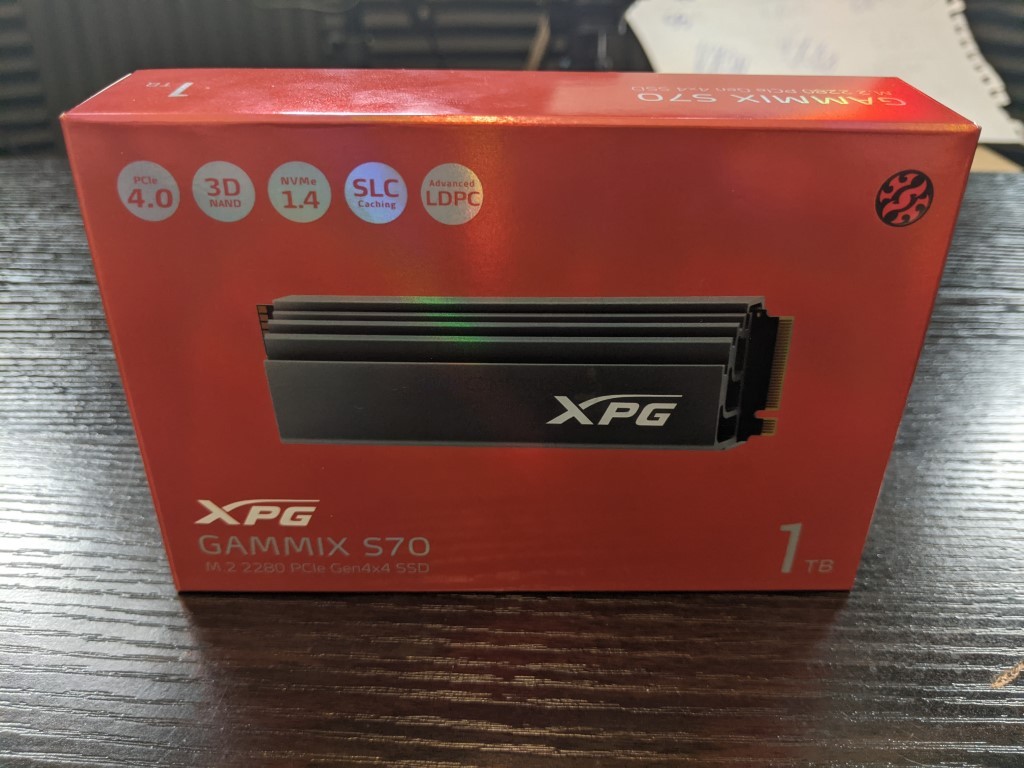
XPG GAMMIX S70 SSD Review – Quick Conclusion
Is the ADATA GAMMIX S70 NVMe SSD the best PCIe SSD to buy right now? It is really hard not to think so! Arriving at a price point that is a noticeable degree lower in price than its competitors, arriving with a higher sequential Read and Write than most of its competitors AND arriving with an included and high-quality heatsink – it is REALLY tough to argue with that! It is by no means perfect, with reported IOPS appearing only a pinch higher than average and fairly standard durability, but these are always going to be factors that are of a specific concern to VERY specific types of buyer. With impressive temperature control, enough architectural differences to stand out from an increasingly busy crowd of PCIe 4 SSDs right now, I think this and the Seagate Firecuda 530 come to an incredibly tied first place for me and even then, the GAMMIX S70 from ADATA still gains an upper hand by virtue of being the better all-round choice for the majority of buyers in 2021/2022. If you are considering buying the ADATA GAMMIX s70 – stop considering and just buy it already!
XPG GAMMIX S70 SSD Review – Packaging
The retail box that the Gammix S70 arrives in is shiny. No, that is not enough. It’s REALLY shiny, covered in holographic sheen and is oozing with gamer focus branding! The box makes a bold impact and although the majority of PCIe 4.0 SSDs in 2021/2022 are quite loud and brash in their presentation, this is a big step up still., especially given that ADATA is generally quite a ‘background’ company in most other components.
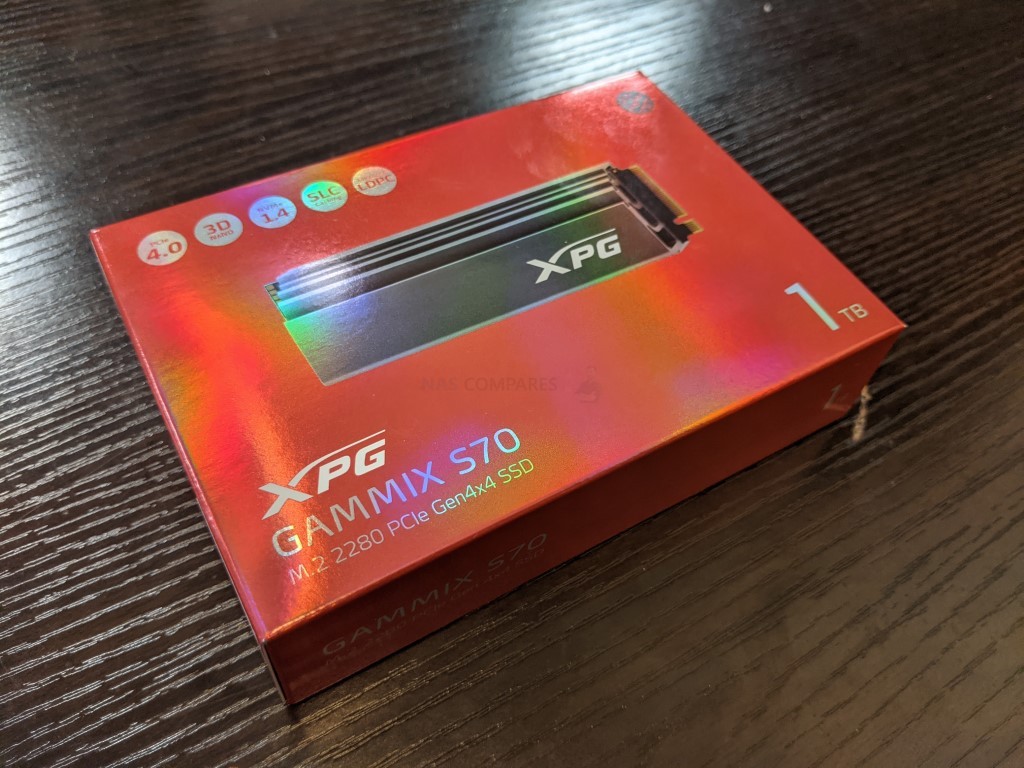
The top left of the retail box highlights a number of the drive’s key features that, although fairly standard in PCIe4 M.2 NVMes of late in most cases, still has a few stand out specs.
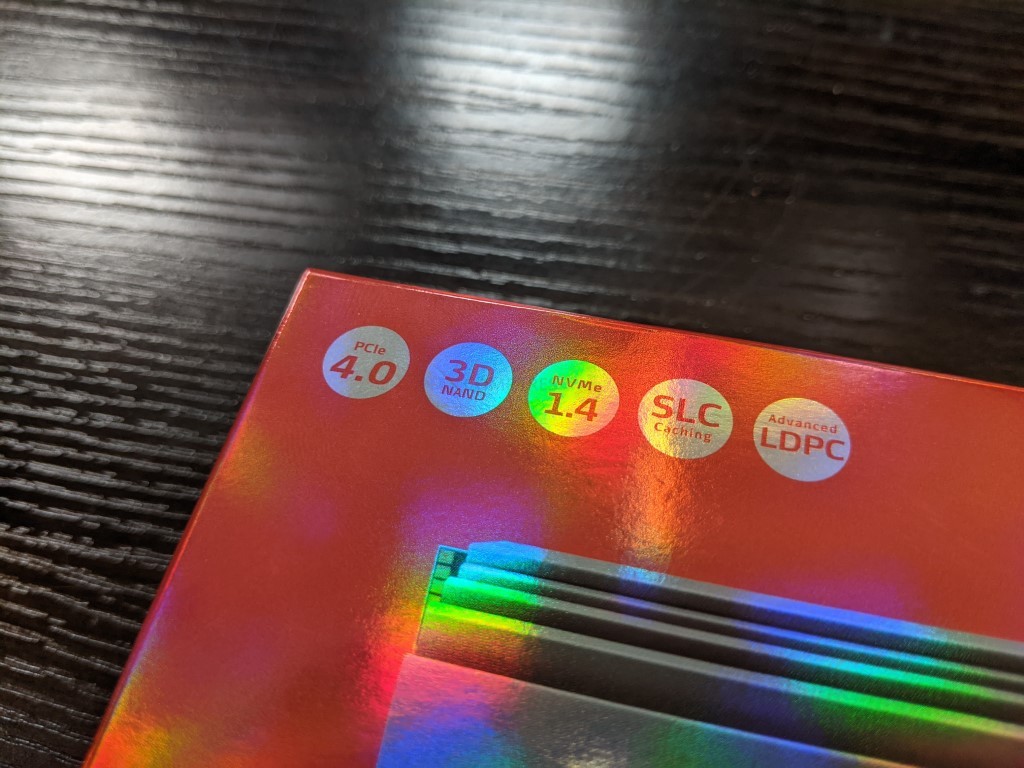
Opening up this retail gives us JUST the XPG GAMMIX S70 SSD. No instructions, warranty information (displayed on the rear of the box) or screws, just the SSD+1st party pre-attached heatsink in a plastic shell.
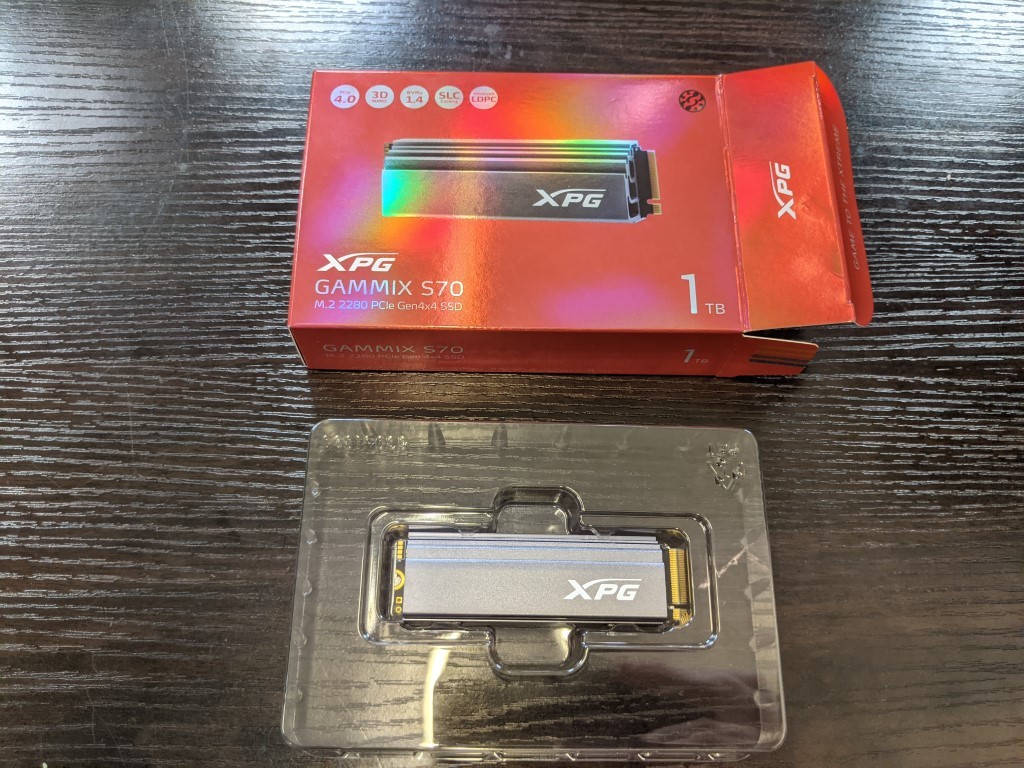
it certainly is a beefy looking SSD in that heatsink, measuring 15mm in height, maybe check the location of where you plan on installing this SSD, as in some cases the height of the heatsink can interfere with your CPU FAN/Heatink physically. It’s a wonderfully unique looking heatsink though and given its inclusion in the price, whilst still remaining competitively prices vs other M.2 PCIe 4 NVMe SSDs, it is a very positive mark in their favour.
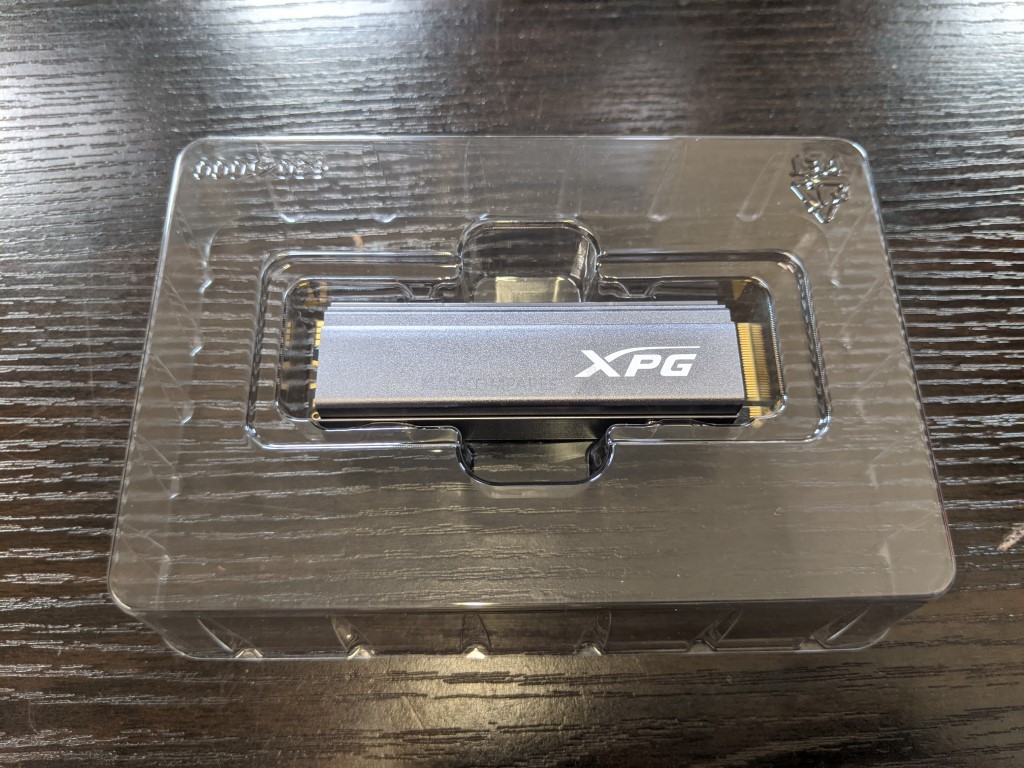
Getting a closer look at this SSD and Heatsink, the ADATA XPG GAMMIX S70 is a chunky drive indeed. Unlike most heatsinks that form a single solid rectangular mass of shaped metal formed for vertical vents, this official heatsink is designed in a far more angular fashion, as well as utilizing a closed vent structure.
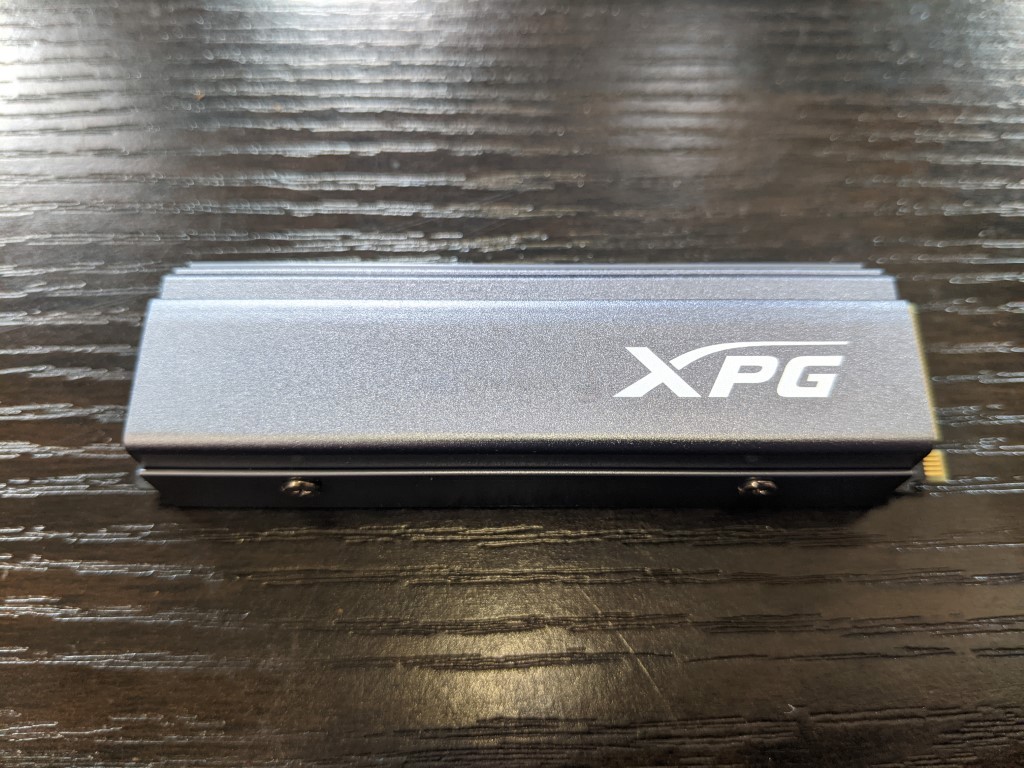
Looking at the heatsink ‘down the barrel’ and you can see that 1, that heat is directed in a curve from the base and 2, it is then fanned out over a shingled layer curve so that each tier is unobstructed in its heat dissipation. In testing the result was that although the heat of the drive was a pinch warmer than most in idle (measured by CrystalDisk), it never hit the same height as other heatsinks in the most intense tests. This might even be arguable more beneficial, as it will keep the NAND warm but not keep the controller hot (temp graph further blow in the tests)
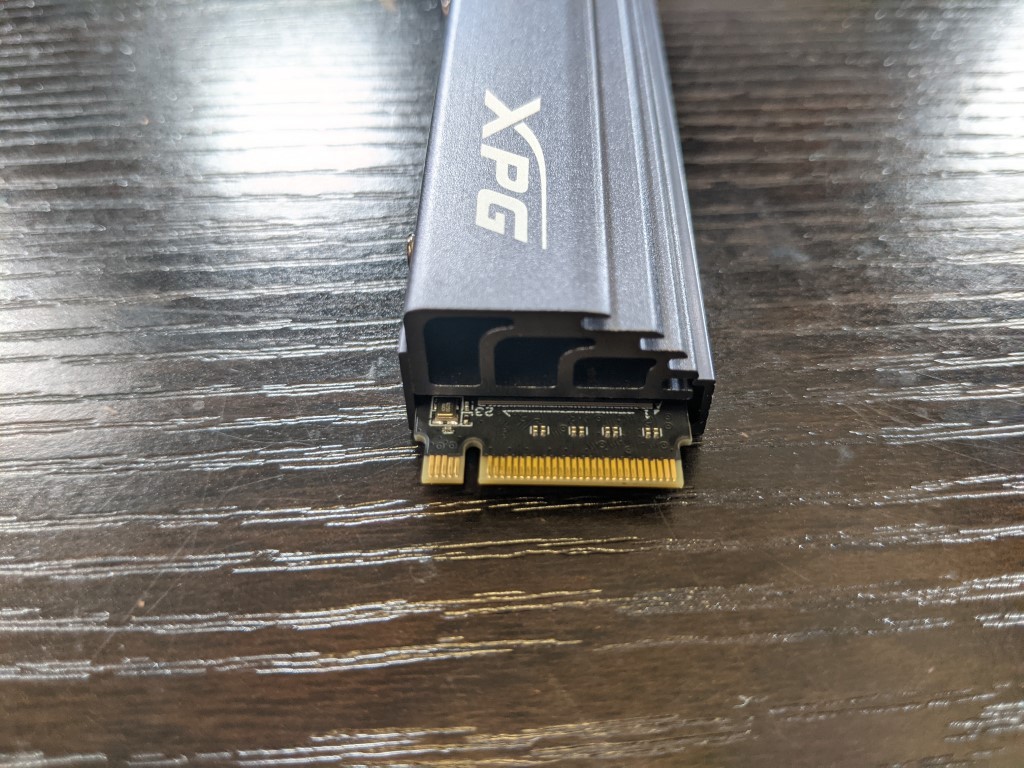
Nonetheless, this IS a very tall heatsink and can certainly see it being problematic in shuttle/mini-ATX setups.
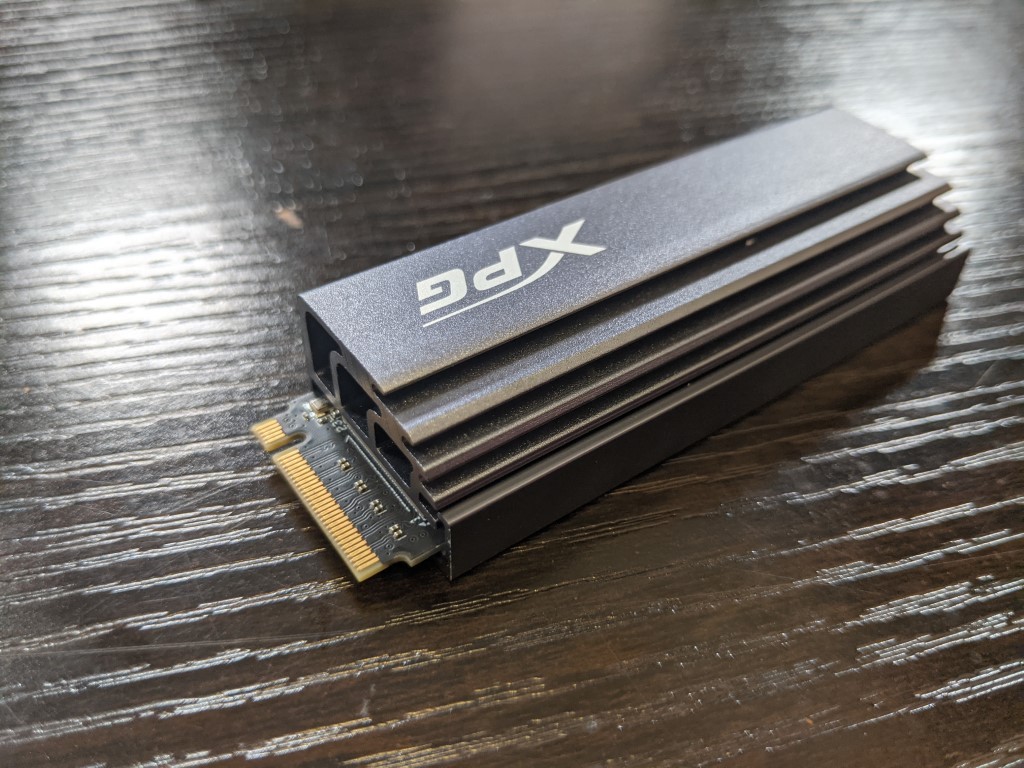
The base of the heatsink is quite basic, featuring the model IS/Manufacturer details, as well as the usual certification stamps. Additionally, you can make out a thermal pad under the SSD, despite the drive being single-sided.
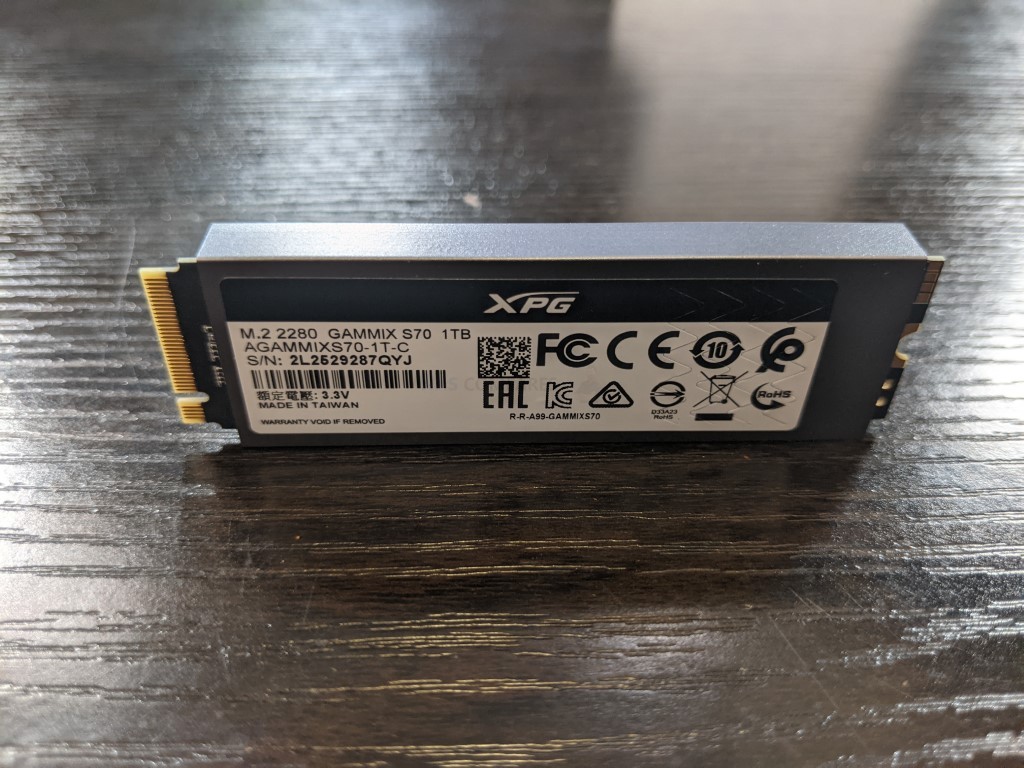
For those of you who have been considering the ADATA XPG GAMMIX S70 for installation in the PS5 SSD expansion slot to increase storage, I am pleased to confirm that this SSD is 100% supported by the system (currently in software beta, but the Gammix S70 will definitely be on the compatibility list of the full software update release. However, the physical installation needs highlighting.
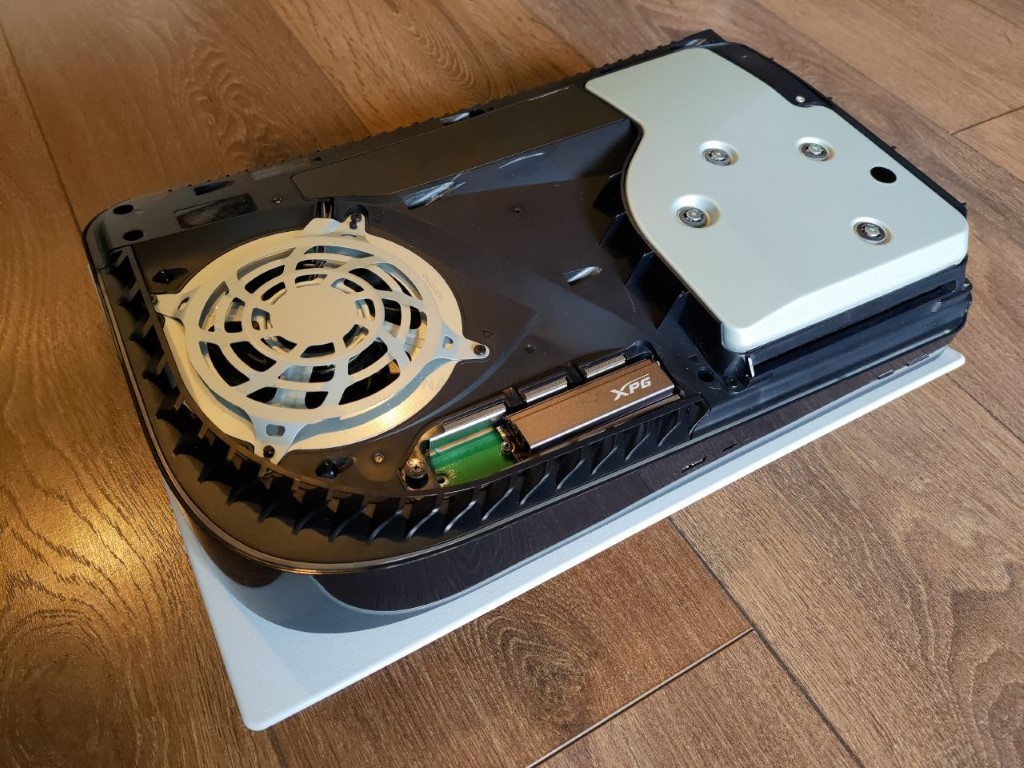
That unique, inclusive and highlight effective is certainly a nice unit, but in terms of PS5 installation – a bit OTT! Completely filling the slot up to the 2280 mark, it protrudes from the bay and although you can still attach the consoles external panels, you cannot apply the metal bay cover.
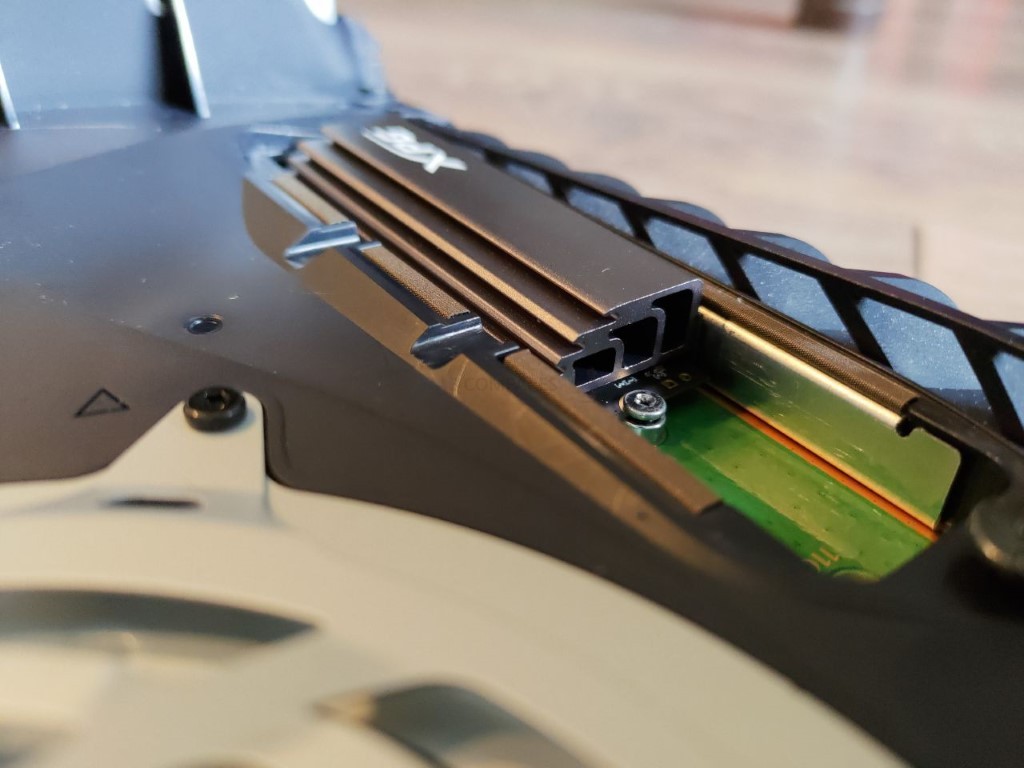
Installing the ADATA Gammix S70 in the PS5 M.2 SSD bay at startup allows you to run a benchmark on the drive. Oddly, despite the high performance of this SSD, the PS5 rated the drive at 6,235MB/s in its initial benchmark. Later testing brought this figure much higher to 6,651MB/s, however in the spirit of fairness against other SSD, I am recording the first attempt.
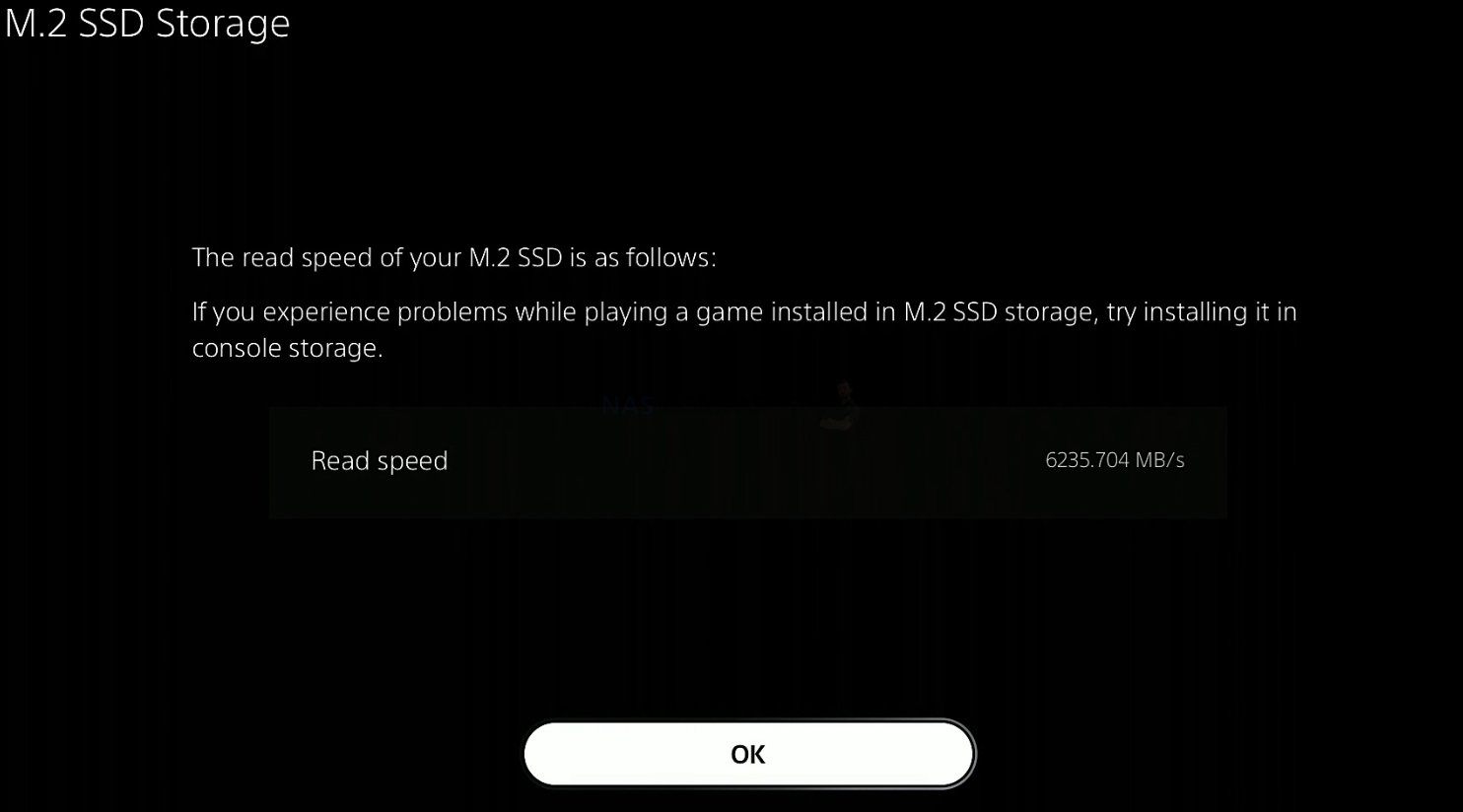
The included heatsink on the XPG Gammix S70 is held in place by 2 SSDs on one side (locked in under a metal lip on the other side) and is very firmly held in place.
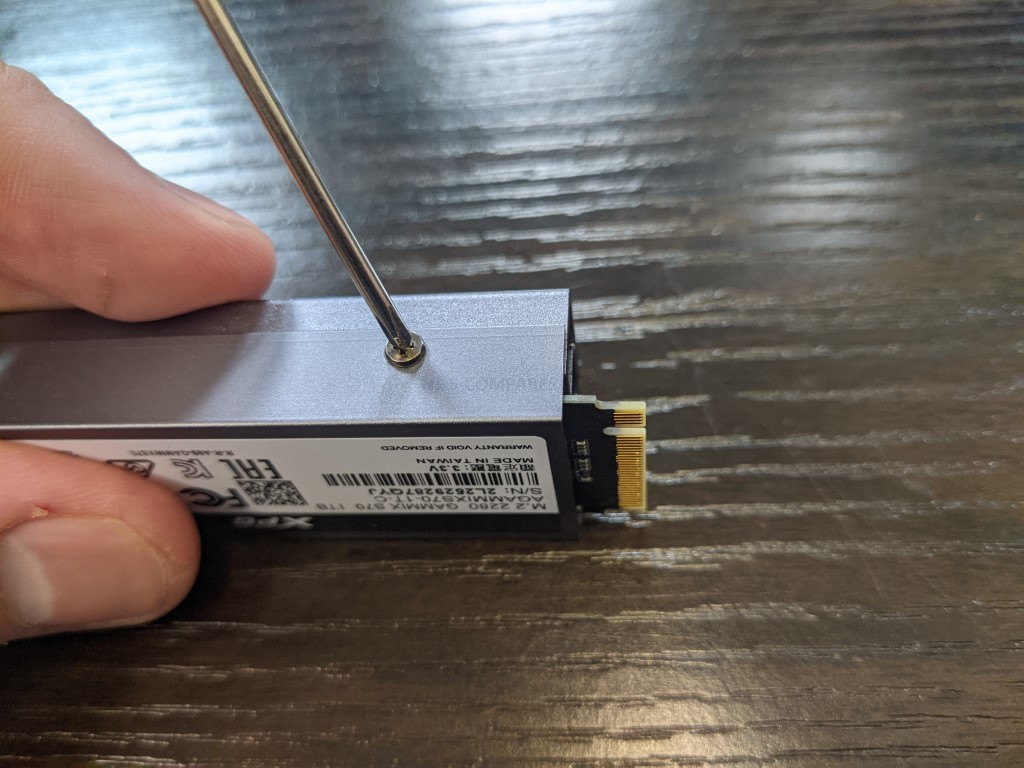
Removing the top part of the heatsink revealed the assortment of onboard chips that I will touch on later, but it is definitely worth revisiting the subject of heatsinks and the advantages of ones that are applied by the same manufacturer as the SSD.
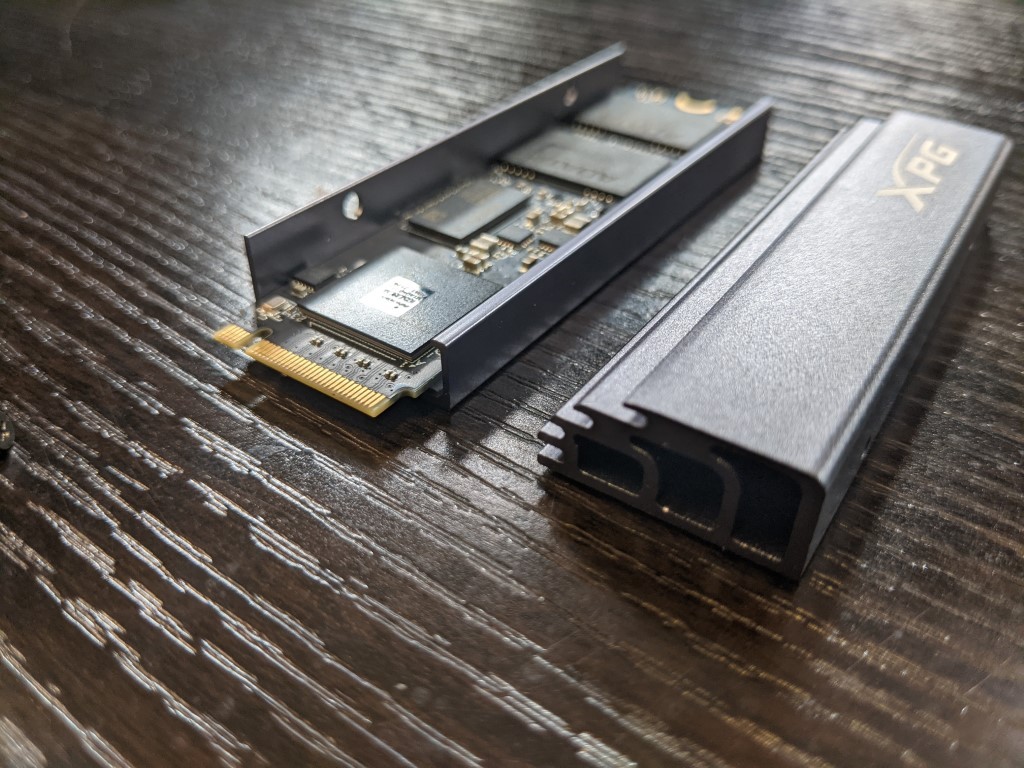
As you can see from the thermal pad shape and placement below, it has been specifically made to cover the most important components in their precise location (rather than a general large strip of thermal padding that is much less efficient at the expense of trying to cover everything!
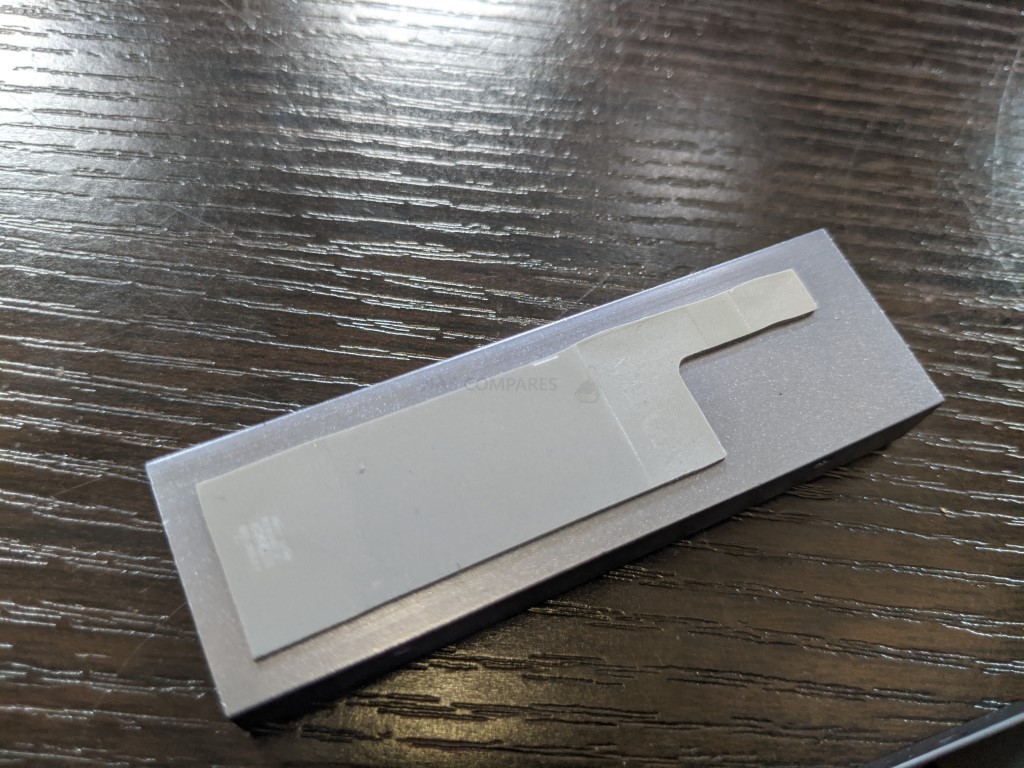
The fact that ADATA includes the heatsink with your purchase of the XPG GAMMIX S70 will always be attractive to buyers who want hassle from installation, as well as doing so at no additional cost and STILL arriving at a lower price point than many competitors is inarguably appealing. So that is the physical design of the XPG GAMMIX S70 SSD. But what about the hardware components themselves? Does the XPG GAMMIX S70 cut the mustard in terms of current generation hardware and protocols? Let’s find out.
XPG GAMMIX S70 SSD Review – Hardware Specifications
As you might expect from an M.2 NVMe SSD that boldly promises performance of over 7,000MB/s sequential read (ie BIG data), the hardware specifications and architecture of the XPG GAMMIX S70 are quite modern. Indeed, for all the big talk of the Seagate Firecuda 530 hardware (still currently the ‘score to beat’ PCIE Gen4 m.2 NVMe right now) being top tier, the XPG GAMMIX S70 is pretty darn similar on the spec sheet! Below is how it looks:
| ADATA GAMMIX S70
|
|
| PCIe Generation | PCIe Gen 4 |
| NVMe Rev | NVMe 1.4 |
| NAND | 3D TLC Micron 96L |
| Max Capacity | 2TB – Single Sided |
| Controller | Innogrit IG5236 |
| Warranty | 5yr |
I know a lot of the above will seem needlessly technical, so below we can bring the most important considerations into sharper focus.
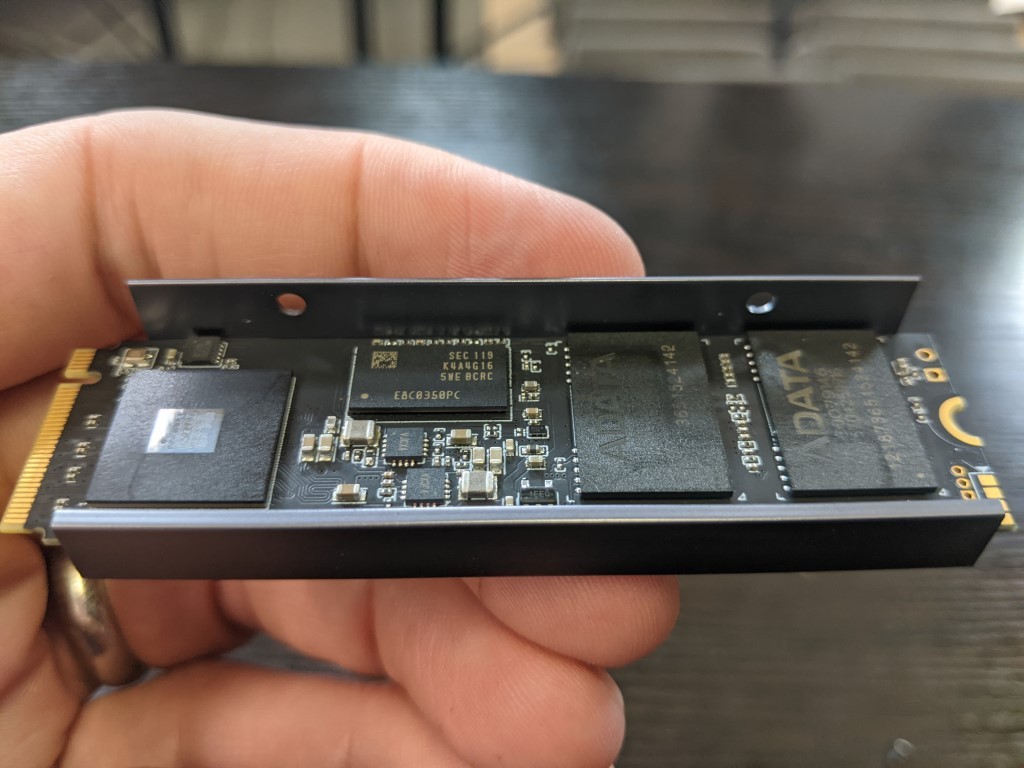
Hardware Focus of the XPG GAMMIX S70 SSD Series
The first big, BIG thing to remember here is the controller, that Innogrit RainIer IG5236. An SSD is much like a microcosm version of a whole computer. The Controller is equivalent to the CPU, and although Inoogrit has produced several high profile SSD controllers in the last few years, this is their first PCIe 4.0 controller. This is a particularly big deal when most reports and measurements seemingly indicate that the Innogrit IG2536 is higher in performance than the Phison E18 controller used by most other recent PCIe 4 M.2 NVMe SSD, as well as because some long-running storage brands like Samsung and WD have most of their development and hardware engineering ‘in-house’ and use their own branded controllers. Indeed, the XPG Gammix S70 is one of very, VERY few SSDs that are using this controller in the home/prosumer gamer sector.
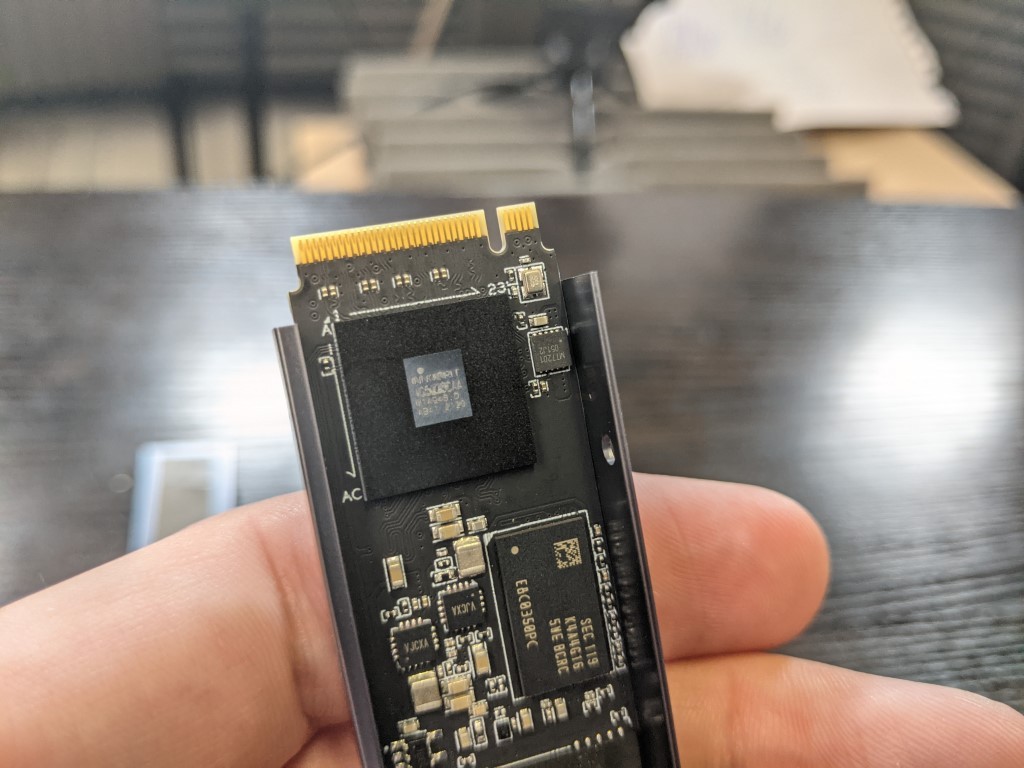
Earlier in 2021, CDRLabs ran performance testing with CrystalDisk on the Gammix S70 SSD, comparing against a Phison E18 SSD of similar architecture (96L 3D TLC NAND, DDR4 RAM, NVMe 1.4, etc) and largely surpassed it by hundreds of Megabytes in Sequential Read and Write performance. So these results tend to back up the increased performance benchmarks that ADATA provide on the XPG S70. This is further improved with a recent software/firmware update for this drive released in August 2021 that further improved the write performance.
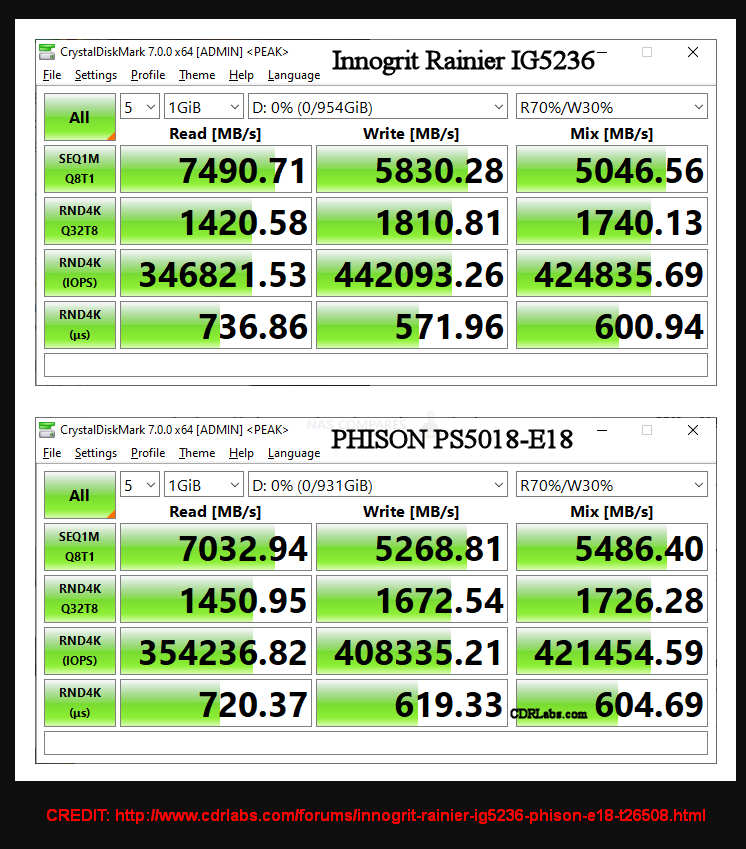
The NAND on the XPG GAMMIX S70 is where the data lives! SSDs (as you no doubt know) do not use moving parts as found in traditional hard drives and instead uses cells that are charged and data is read/written to them in this process. The quality of the NAND and the layers used will make a big difference to the durability and performance of an SSD and although the XPG GAMMIX S70 does not provide the best SSD in the industry at this tier right now (that, once again, goes to the Seagate Firecuda 530 at 176 layer 3D TLC NAND), it is bigger than most, arriving at 96 Layers of 3D TLC NAND. Although the majority of modern PCIe M.2 SSD use 3D TLC NAND (avoid QLC NAND like the PLAGUE btw!), most are still at 64 layers or so, so this is a big jump up for the XPG GAMMIX S70 SSD. Although detailed information on the NAND used is not readily available online, we observed that the XPG GAMMIX S70 featured two blocks of ADATA NAND modules.
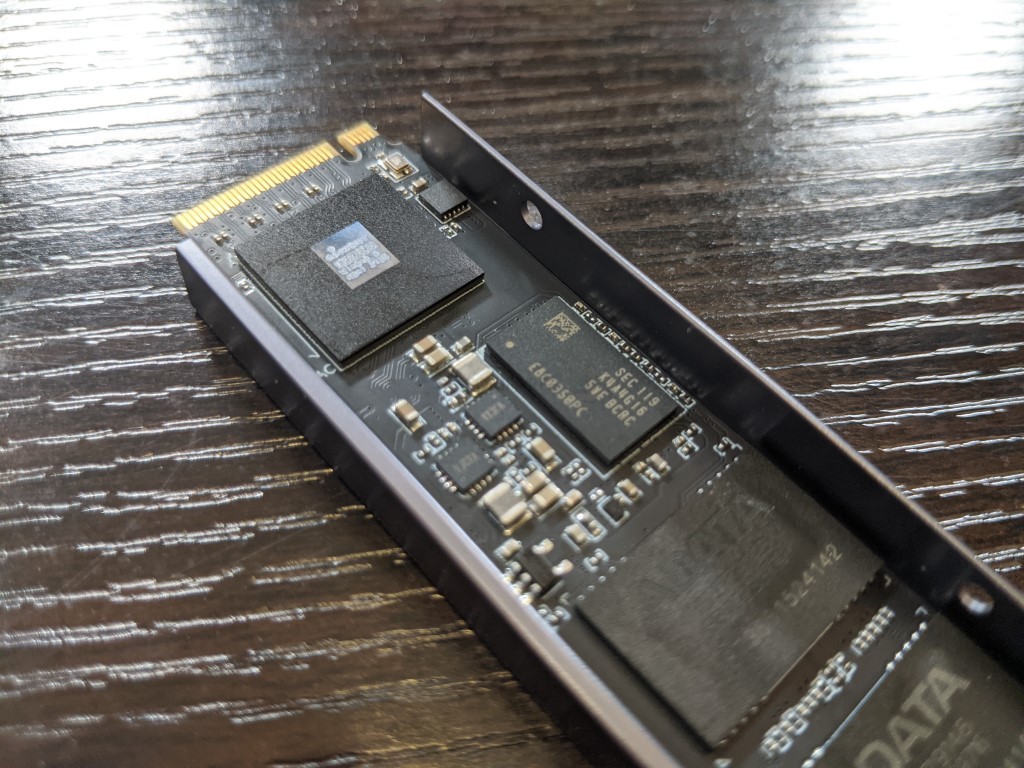
Much like the Controller on the XPG GAMMIX S70 being the ‘CPU’, it also has an area of memory. The XPG GAMMIX S70 SSD uses DDR4 memory on board and this in conjunction with the SSD controller provides a massive body of data handling resources for getting your data moving through the SSD and out of the m.2 NVMe PCIe 4 interface. The amount of memory scales in conjunction with the 1TB or 2TB SSD you use, with 2GB of DDR4 at the on the 2TB tier, 1GB DDR4 on the 1TB, etc.
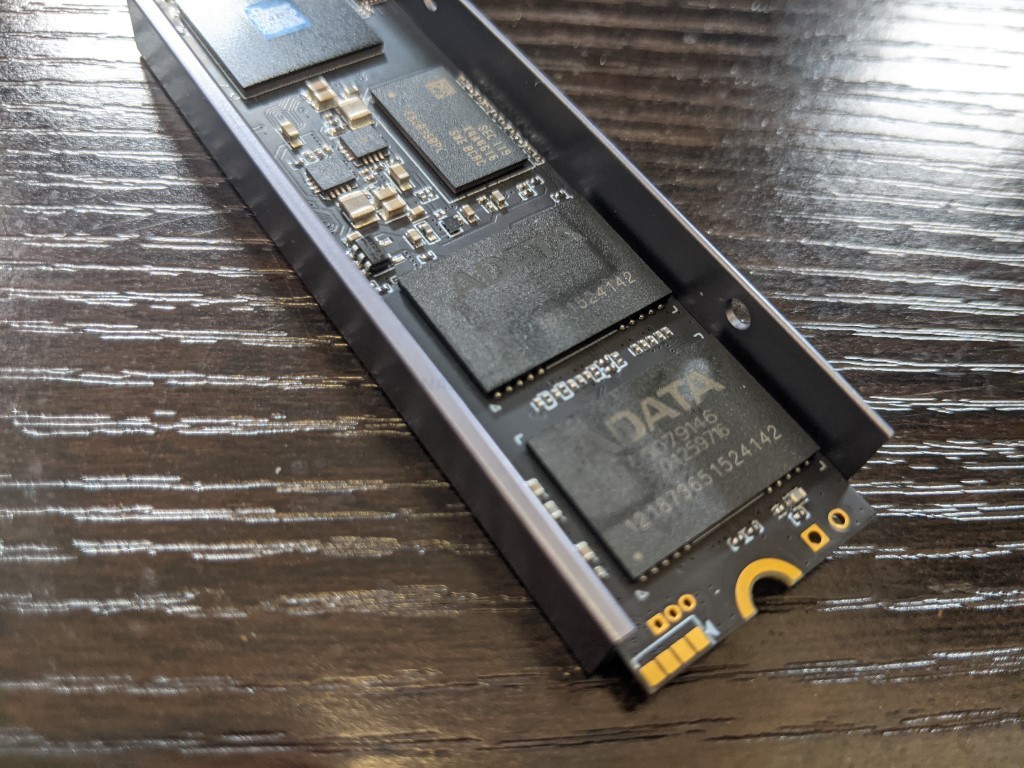
As mentioned, all available capacities of the XPG GAMMIX S70 arrive at 2280 in length. This is quite normal for the 1TB and 2TB versions, but the fact that the 2TB can arrive on single-sided SSD boards is very impressive. Physical storage NAND is distributed evenly in order to space out the storage and allow even cooling, NAND wear and performance.
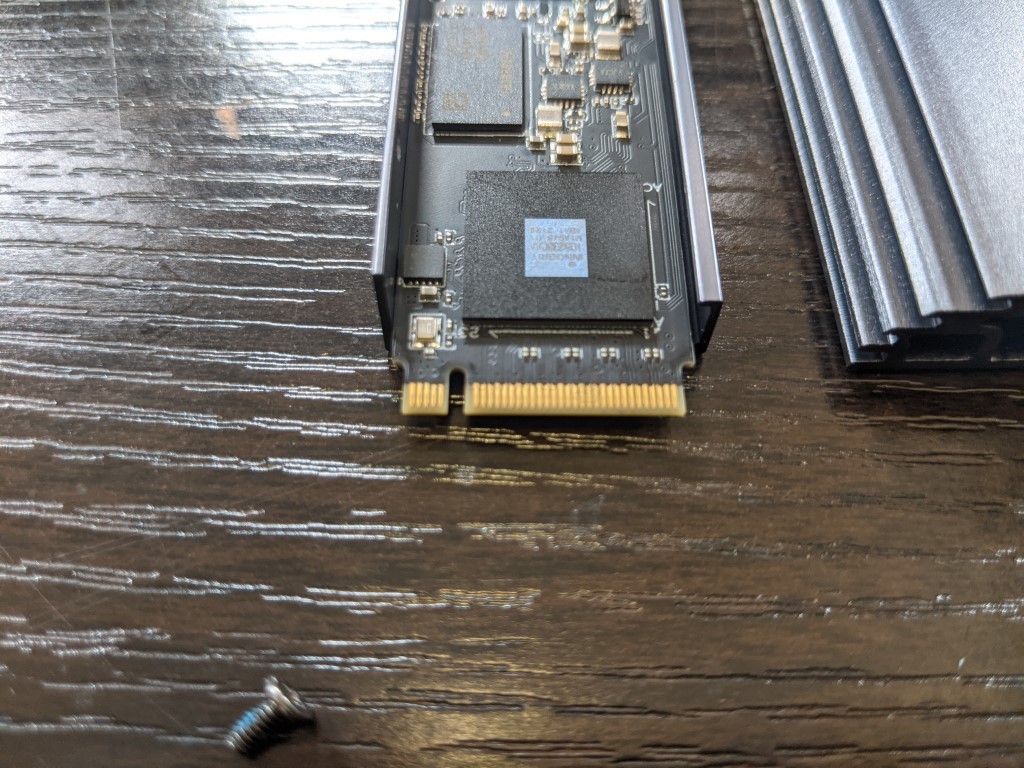
Finally, there is the M.2 NVMe connection. Not all m.2 SSDs are created equal and although M.2 SATA and M.2 NVMe look similar, they provide massively different performance and connectivity. However, the XPG GAMMIX S70 takes it one step further, by using a newer generation of PCIe Connectivity. In short, M.2 NVMe SSDs are connected to the host PC/Console system via PCIe protocol (think of those slots that you almost always use for your graphics cards, but a much, MUCH smaller connector). These allow much larger bandwidth (ie maximum speed) for the connected storage media, Much like regular PCIe slots, they have different versions (i.E PCIe Gen 1, 2, 3, 4, etc) and also a multiplying factor (x1, x2, x4, etc). Up until around 18 months ago, the best M.2 NVMes were M.2 PCIe Gen 3×4 (so a maximum 4,000MB/s possible). However, never generation SSD like the XPG GAMMIX S70 use PCIe Gen 4×4 (a potential 8,000MB/s possible) and it is only now that SSD controllers and NAND production has reached a point where it can catch up and fully saturate (i.e fill) this connection.
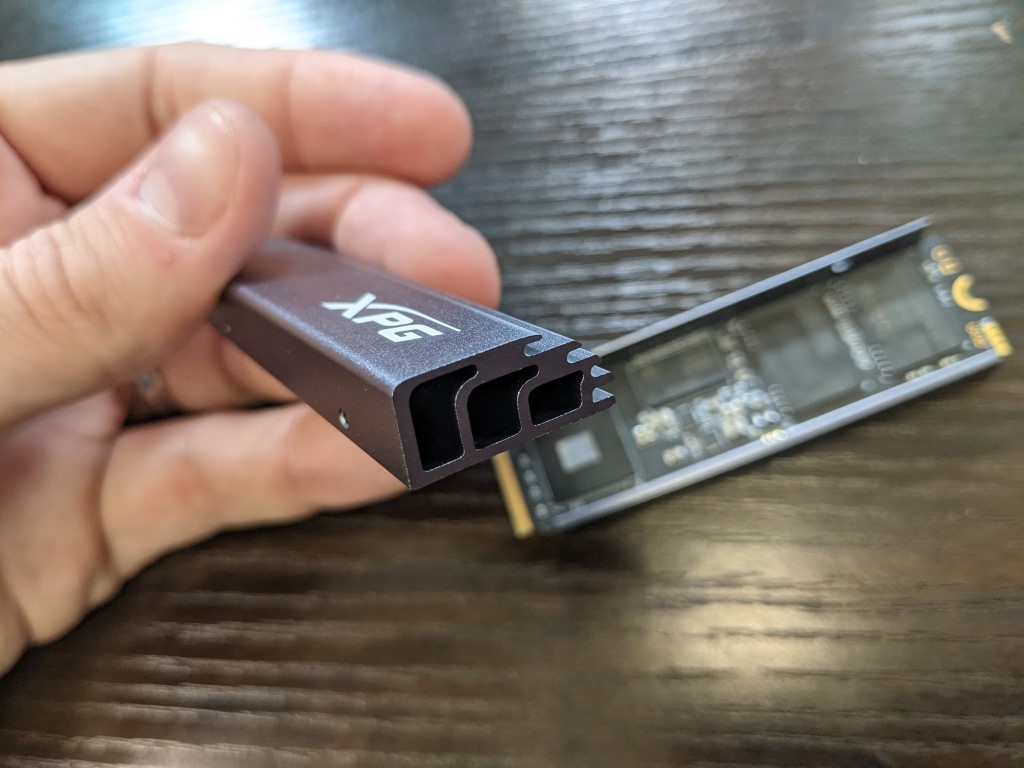
Overall, you really cannot fault the hardware inside/onboard the XPG GAMMIX S70, as it is still (2-3 months after release) higher performing in sequential Read and Write than many other M.2 NVMe PCIe 4 SSDs released in that time. Before we go into the full testing, however, it is worth taking a moment to look closely at the reported performance benchmarks of the XPG GAMMIX S70, as although the performance seems stellar, there are areas such as IOPS and endurance when compared with its main rivals that are worth taking into consideration.
XPG GAMMIX S70 SSD Review – Official Stats First
Before we conduct our own testing on this SSD, Let’s take a closer look at the reported specifications and benchmarks first. The XPG GAMMIX S70 SSD arrives in multiple capacities (below). The Prices currently are a little inconsistent (with each higher capacity tier actually having a higher price per GB – quite unusual) likely due to the hardware shortages, the Pandemic, Chia has affected SSD availability in the last 12 months and most recently the announcement that PS5 supports this SSD and it has increased the current price of both models around 10-20%!. Below is a breakdown of how each competitor drive and the XPG GAMMIX S70 SSD compare:
| Brand/Series | ADATA GAMMIX S70
|
Seagate Firecuda 530
500GB – $149.99, 1TB – $239.99, 2TB – $489.99, 4TB – $949.99 |
WD Black SN850
|
| PCIe Generation | PCIe Gen 4 | PCIe Gen 4 | PCIe Gen 4 |
| NVMe Rev | NVMe 1.4 | NVMe 1.4 | NVMe 1.4 |
| NAND | 3D TLC Micron 96L | 3D TLC Micron B47R 176L | BiCS4 96L TLC |
| Max Capacity | 2TB – Single Sided | 4TB – Double Sided | 2TB |
| Controller | Innogrit IG5236 | Phison E18-PS5018 | WD_BLACK G2 |
| Warranty | 5yr | 5yr | 5yr |
| 500GB Model | N/A | ZP500GM3A013 | WDS500G1X0E-00AFY0 |
| Price in $ and $ | N/A | $139 / £119 | $119 / £99 |
| 1TB Model | AGAMMIXS70-1T-C | ZP1000GM3A013 | WDS100T1X0E-00AFY0 |
| Price in $ and $ | $199 / £175 | $239 / £199 | $249 / £169 |
| 2TB Model | AGAMMIXS70-2T-C | ZP2000GM3A013 | WDS200T1X0E-00AFY0 |
| Price in $ and $ | $399 / £355 | $419 / £379 | $399 / £339 |
| 4TB Model | N/A | ZP4000GM3A013 | N/A |
| Price in $ and $ | N/A | $949 / £789 | N/A |
| 500GB Model | N/A | ZP500GM3A013 | WDS500G1X0E-00AFY0 |
| Total Terabytes Written (TBW) | N/A | 640TB | 300TB |
| Mean Time Between Failures (MTBF, hours) | N/A | 1,800,000 | 1,750,000 |
| DWPD | N/A | 0.7DWPD | 0.3DWPD |
| 1TB Model | AGAMMIXS70-1T-C | ZP1000GM3A013 | WDS100T1X0E-00AFY0 |
| Total Terabytes Written (TBW) | 740TB | 1275TB | 600TB |
| Mean Time Between Failures (MTBF, hours) | 2,000,000 | 1,800,000 | 1,750,000 |
| DWPD | 0.4DWPD | 0.7DWPD | 0.3DWPD |
| 2TB Model | AGAMMIXS70-2T-C | ZP2000GM3A013 | WDS200T1X0E-00AFY0 |
| Total Terabytes Written (TBW) | 1480TB | 2550TB | 1200TB |
| Mean Time Between Failures (MTBF, hours) | 2,000,000 | 1,800,000 | 1,750,000 |
| DWPD | 0.4DWPD | 0.7DWPD | 0.3DWPD |
| 4TB Model | N/A | ZP4000GM3A013 | N/A |
| Total Terabytes Written (TBW) | N/A | 5100TB | N/A |
| Mean Time Between Failures (MTBF, hours) | N/A | 1,800,000 | N/A |
| DWPD | N/A | 0.7DWPD | N/A |
There are clear throughput improvements as you rise through the capacity tiers (not unusual), as does the rated 4K IOPS. Though one area worth focusing on a little is that TBW (terabytes Written) and DWPD (Drive writes per day), as this drive is rated a pinch higher than the Samsung 980 Pro and WD Black SN850 in terms of NAND lifespan on daily writes, likely down to that 96 Layer 3D TLC NAND used, rather than t used by those used by competitors. This is an important point because the brand has significantly less ‘end user’ recognition in-home/business SSD media than the likes of Samsung, WD and Seagate and people will want to know they are going to get a product from a brand that they have heard of.
However, despite the use of the Innogrit Rainier IG5236 controller and 96 layer NAND, the reported IOPS on each capacity is actually a noticeable degree lower (for the most part) than those reported by their competitors. Indeed, the XPG GAMMIX S70 is one of the few SSD/Memory focused brands with a PCIe 4.0 SSD that does not cross into the reported 1 Million IOPS mark, maxing out at 740k. This is still very impressive anyway, but it does make me wonder where the disparity stems from. Indeed, when you look at the bulk of PCIe 4×4 M.2 NVMe 1.4 SSD that feature the E18 controller and 96L (or higher) on board, it really only leaves about 4 other SSDs in the market today that this can be compared against. The Sabrent Rocket 4 Plus, the MSI Spatium M480, the Gigabyte Aorus 7000s and (current leader) the Seagate Firecuda 530. Of those, the only one that seemingly ‘out specs’ the XPG GAMMIX S70 is the Seagate Firecuda 530. However, the XPG GAMMIX S70 SSD has been available in the market for longer and has certainly embedded itself in the minds and budget’s of PC/PS5 gamers who think the Firecuda 530 is too expensive and the others are less impress – it makes a very appealing middle ground. Below is how these drives compare in terms of throughput and IOPS:
| Brand/Series | ADATA GAMMIX S70
|
Seagate Firecuda 530
500GB – $149.99, 1TB – $239.99, 2TB – $489.99, 4TB – $949.99 |
WD Black SN850
|
| 500GB Model | N/A | ZP500GM3A013 | WDS500G1X0E-00AFY0 |
| Sequential Read (Max, MB/s), 128 KB | N/A | 7000MB | 7000MB |
| Sequential Write (Max, MB/s), 128 KB | N/A | 3000MB | 4100MB |
| 1TB Model | AGAMMIXS70-1T-C | ZP1000GM3A013 | WDS100T1X0E-00AFY0 |
| Sequential Read (Max, MB/s), 128 KB | 7400MB | 7300MB | 7000MB |
| Sequential Write (Max, MB/s), 128 KB | 5500MB | 6000MB | 5300MB |
| 2TB Model | AGAMMIXS70-2T-C | ZP2000GM3A013 | WDS200T1X0E-00AFY0 |
| Sequential Read (Max, MB/s), 128 KB | 7450MB | 7300MB | 7000MB |
| Sequential Write (Max, MB/s), 128 KB | 6800MB | 6900MB | 5100MB |
| 4TB Model | N/A | ZP4000GM3A013 | |
| Sequential Read (Max, MB/s), 128 KB | N/A | 7300MB | N/A |
| Sequential Write (Max, MB/s), 128 KB | N/A | 6900MB | N/A |
| Brand/Series | ADTA GAMMIX S70 | Seagate Firecuda 530 | WD Black SN850 |
| 500GB Model | N/A | ZP500GM3A013 | WDS500G1X0E-00AFY0 |
| Random Read (Max, IOPS), 4 KB QD32 | N/A | 400,000 | 1,000,000 |
| Random Write (Max, IOPS), 4 KB QD32 | N/A | 700,000 | 680,000 |
| 1TB Model | AGAMMIXS70-1T-C | ZP1000GM3A013 | WDS100T1X0E-00AFY0 |
| Random Read (Max, IOPS), 4 KB QD32 | 350000 | 800000 | 1,000,000 |
| Random Write (Max, IOPS), 4 KB QD32 | 720000 | 1000000 | 720,000 |
| 2TB Model | AGAMMIXS70-2T-C | ZP2000GM3A013 | WDS200T1X0E-00AFY0 |
| Random Read (Max, IOPS), 4 KB QD32 | 650,000 | 1,000,000 | 1,000,000 |
| Random Write (Max, IOPS), 4 KB QD32 | 740,000 | 1,000,000 | 710,000 |
| 4TB Model | N/A | ZP4000GM3A013 | |
| Random Read (Max, IOPS), 4 KB QD32 | N/A | 1,000,000 | N/A |
| Random Write (Max, IOPS), 4 KB QD32 | N/A | 1,000,000 | N/A |
Yes, that is a LONG table, but you can immediately see that the Seagate Firecuda 530 raises the stakes on all of the key specifications. Although there are a number of micro reasons for this, the 176L NAND is the biggest factor here. Yes, that is why the Firecuda 530 commands the higher price tag. Additionally, the WD Black arriving at a better price point, higher IOPS in most tiers and the fact it does this whilst still hitting that 7,000MB/s certainly gives pause for thought. However, for many, the additional cost for higher durability they may never need, peak performance their core system will not reach and IOPS rating that their larger file handling will never utilize will mean that holding out for the Firecuda or WD Black SN850 is not in their interest. Both SSDs (on paper at this stage!) are fantastic examples of where consumer and prosumer SSDs are evolving towards. Remember that you can get 1TB of XPG GAMMIX S70 for the same price as 500GB of the Firecuda 530 – which given the similarity of that performance means that you are getting incredible value! Let’s get the XPG GAMMIX S70 on the test machine!
Testing the XPG GAMMIX S70 m.2 PCIE4 NVMe SSD
The XPG GAMMIX S70 was selected for this test and it was tested using multiple benchmark tools, from a cold boot, in the 2nd storage slot (i.e not the OS drive). Each test was conducted three times (full details of this are shown in the YouTube Review of the XPG GAMMIX S70 over on NASCompares):
Test Machine:
- Windows 10 Pro Desktop System
- Intel i5 11400 Rocket Lake – 6-Core 2.6/4.4Ghz
- 16GB DDR4 2666MHz Memory
- Intel B560M mATX Motherboard
- OS Storage, Seagate Firecuda 120 SSD
- Test SSD connected to Secondary PCIe Gen 4 M.2 Slot
Using CrystalDisk, we got a good measure of the drive and verified that this PCIe Gen 4 x4 SSD was indeed using the 4×4 lane. Additionally, the temp averaged out a little higher in idle than most previously tested SSD, HOWEVER, the ADATA Gammix S70 heatsink kept the drive at a consistent temp of late 40’s for most of the tests and did an incredible job of maintaining a working temp without spiralling too high between each one being conducted.
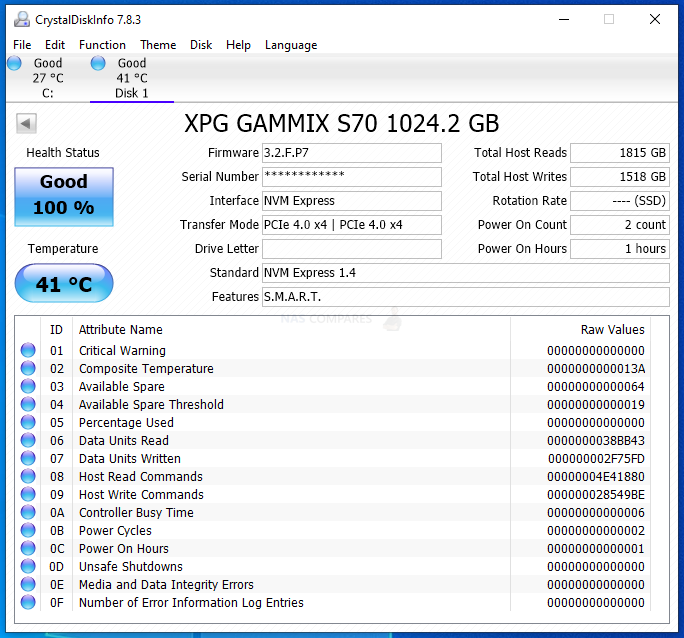
The first tests were conducted using the ATTO disk benchmark software. The first was a 256MB test file size and below is a breakdown of the transfer rates and IOPS. The 2nd Test was a 1GB test file and finally, the last test was with a 4GB test file. The system was given 1-minute cool downtime between tests, no screen recording software was used (remove overhead) and a heatsink was used throughout (no reboots)
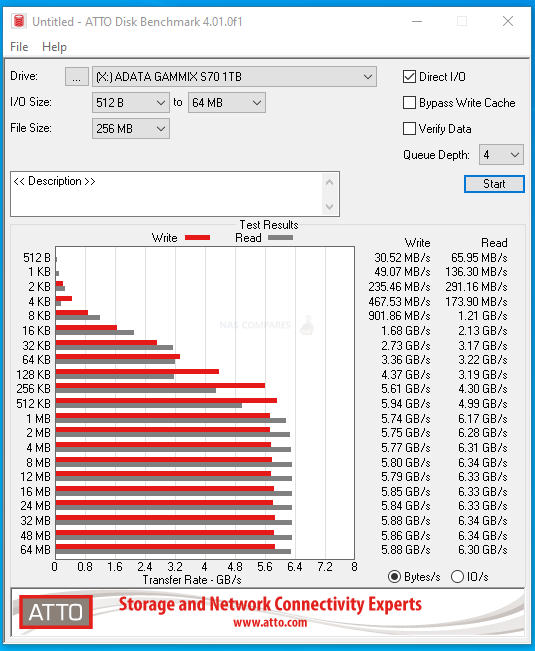 |
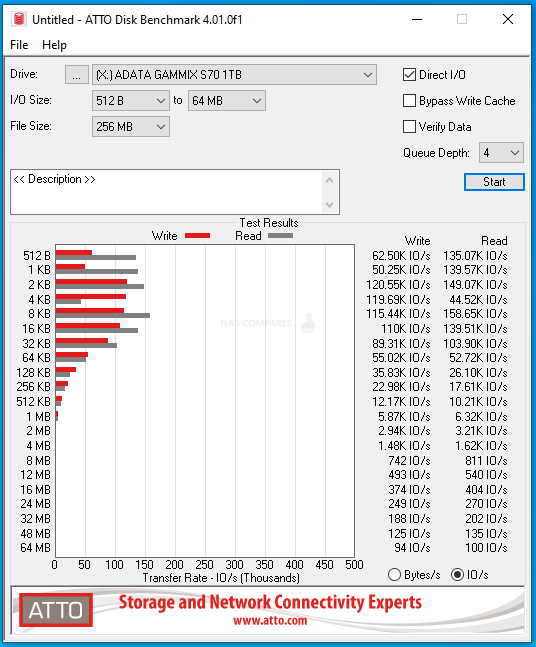 |
ATTO Disk Benchmark Test #1
256MB File PEAK Read Throughput = 6.34GB/s
256MB File PEAK Write Throughput = 5.94GB/s
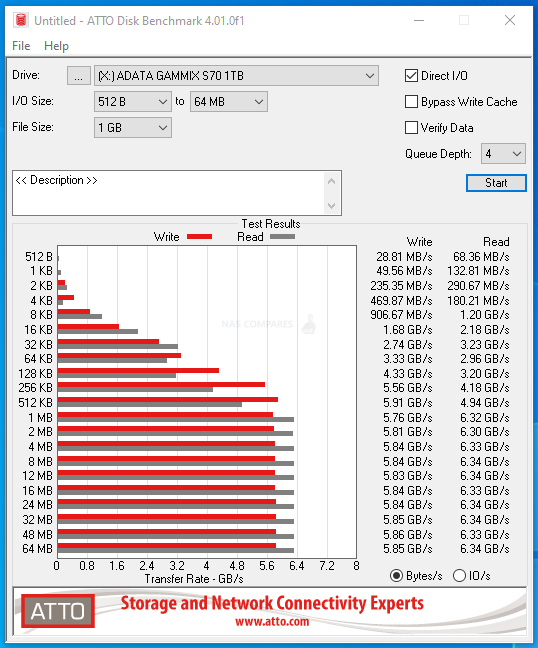 |
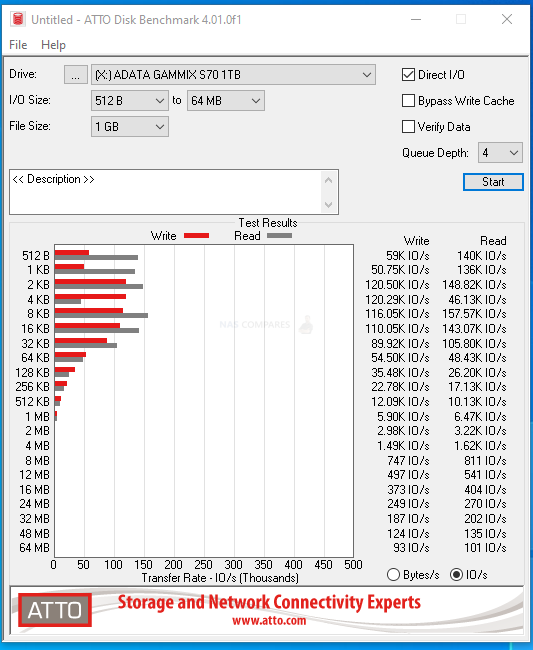 |
ATTO Disk Benchmark Test #2
1GB File PEAK Read Throughput = 6.34GB/s
1GB File PEAK Write Throughput = 5.91GB/s
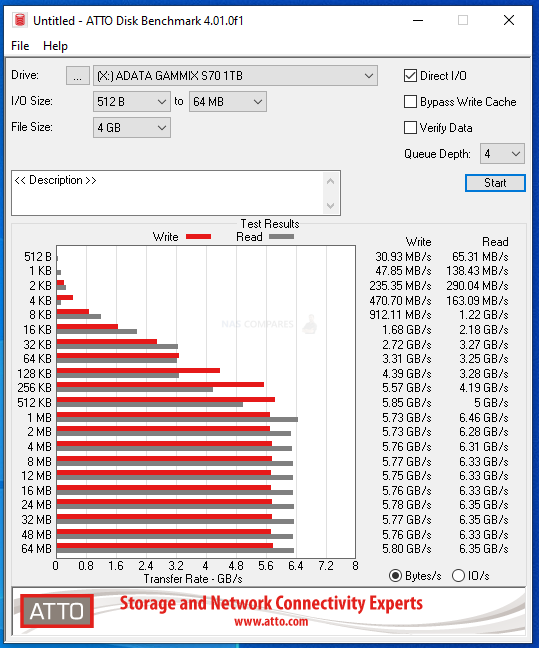 |
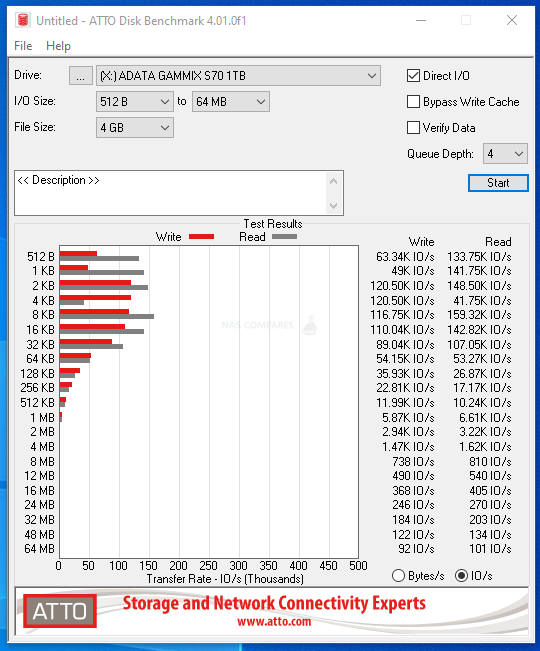 |
ATTO Disk Benchmark Test #3
4GB File PEAK Read Throughput = 6.46GB/s
4GB File PEAK Write Throughput = 5.85GB/s
Next, although the ATTO tests were quite good, but not what I would have hoped from this SSD, so I moved on to the Crystal Disk Mark testing to see how well it would handle our lasts barrage of tests. The first test was the 1GB file testing, which measured both sequential and random, as well as the read and write IOPS. Test were conducted on a 1GB, 4GB and 16GB Test File. I also included a mixed 70/30 read and write task to give a little bit more of a realistic balanced workload. These tests were conducted with 1-minute cooling break in between
CRYSTALDISK MARK 1GB TEST
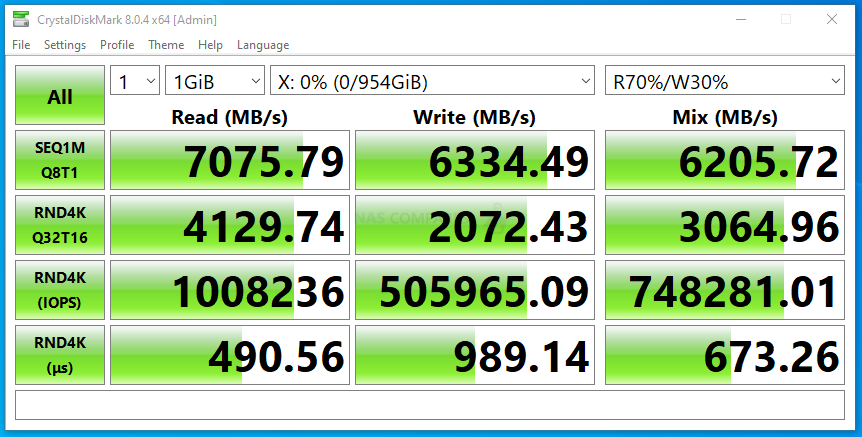
CRYSTALDISK MARK 4GB TEST
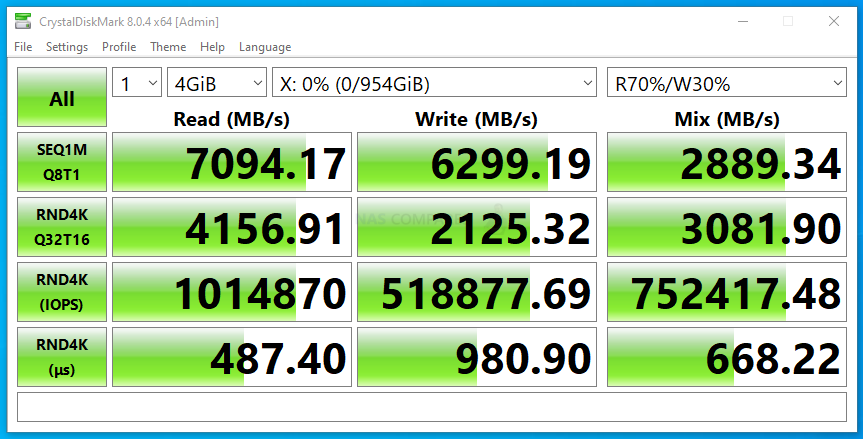
CRYSTALDISK MARK 16GB TEST
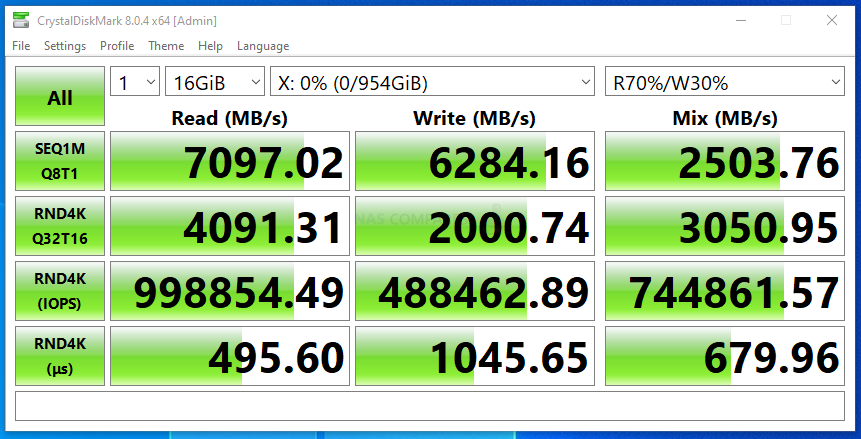
Next, I switched to AS SSD benchmark. A much more thorough test through, I used 1GB, 3GB and 5GB test files. Each test includes throughput benchmarks and IOPS that are respective to the larger file sizes (important, if you are reading this and trying to compare against the reported 4K IOPS from the manufacturer).
AS SSD Benchmark Test #1
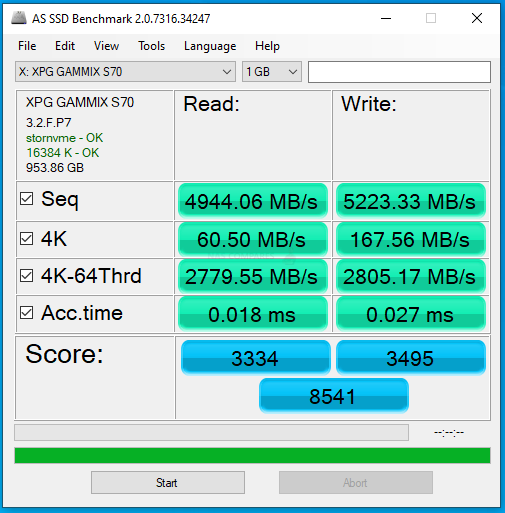 |
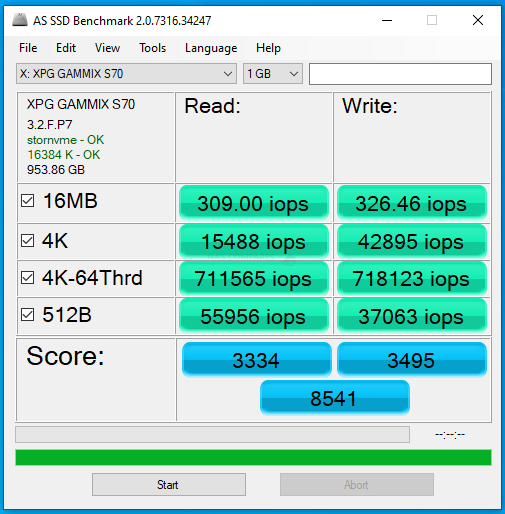 |
AS SSD Benchmark Test #2
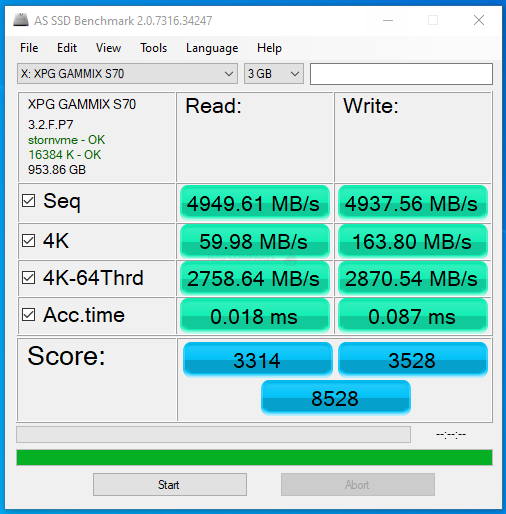 |
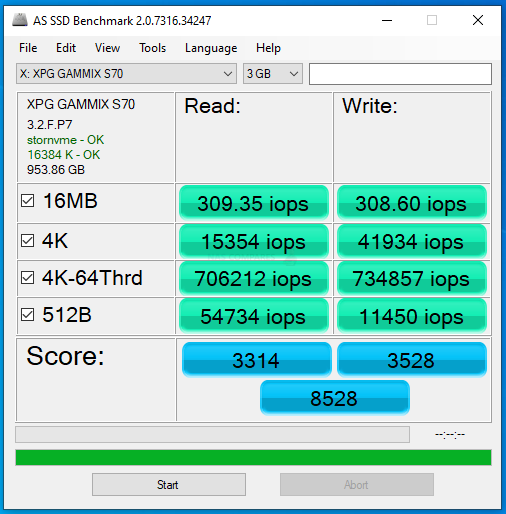 |
AS SSD Benchmark Test #3
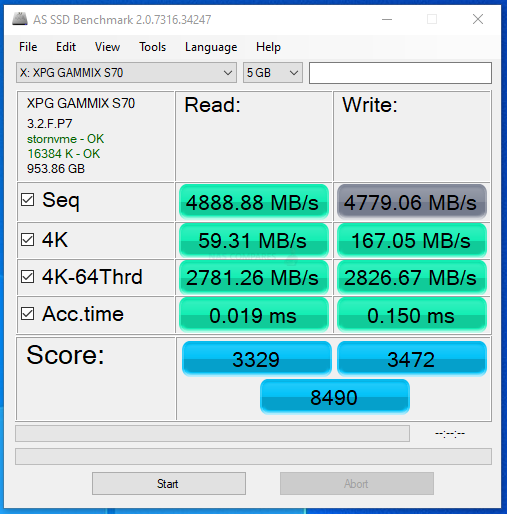 |
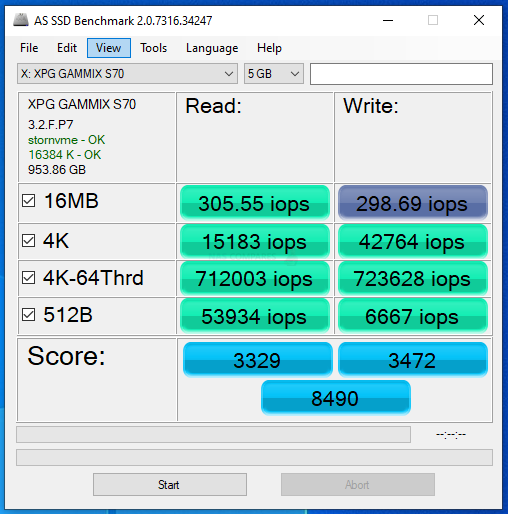 |
Ordinarily, I would introduce tests like BlackMagic and AJA into the mix here, but even a short burst of testing on an NVMe like this would over saturate the cache memory on board. Nevertheless, in the short term we still could ascertain the reported performance on 1GB, 4GB and 16GB file testing was:
1GB AJA File Test Results (Peak) = 5861MB/s Read & 5039MB/s Write

4GB AJA File Test Results (Peak) = 5874MB/s Read & 5127MB/s Write

16GB AJA File Test Results (Peak) = 5881MB/s Read & 5218MB/s Write

Throughout the testing, the XPS GAMMMIX S70 SSD started at a slightly higher than average temp, but maintained a good operational temperature throughout the whole testing:
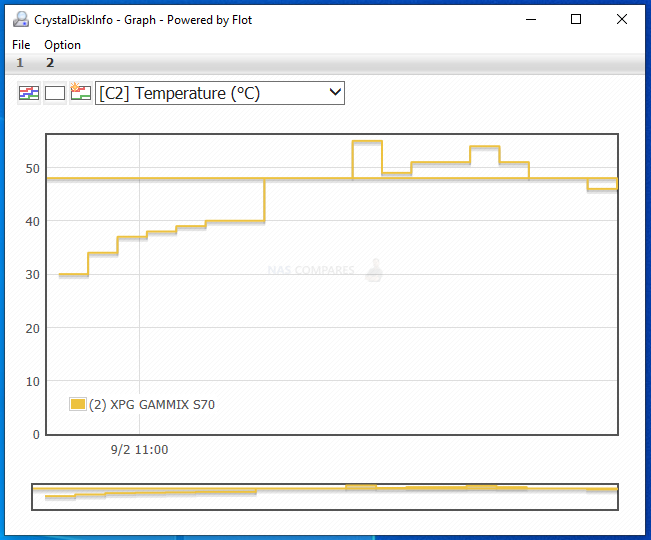
Overall, the XPG GAMMIX S70 was certainly able to provide some solid performance, as well as potentially exceed the test figures here on a more powerful machine. Given the reported Read and Write statistics that the brand has stated publically, I think there is enough evidence here to back up those claims. IOPs were a little lower than I expected, but again, we were testing very large file types, so this would have to be taken in context.
XPG GAMMIX S70 SSD Review – Conclusion
Is the ADATA GAMMIX S70 NVMe SSD the best PCIe SSD to buy right now? It is really hard not to think so! Arriving at a price point that is a noticeable degree lower in price than its competitors, arriving with a higher sequential Read and Write than most of its competitors AND arriving with an included and high-quality heatsink – it is REALLY tough to argue with that! It is by no means perfect, with reported IOPS appearing only a pinch higher than average and fairly standard durability, but these are always going to be factors that are of a specific concern to VERY specific types of buyers. With impressive temperature control, enough architectural differences to stand out from an increasingly busy crowd of PCIe 4 SSDs right now, I think this and the Seagate Firecuda 530 come to an incredibly tied first place for me and even then, the GAMMIX S70 from ADATA still gains an upper hand by virtue of being the better all-round choice for the majority of buyers in 2021/2022. If you are considering buying the ADATA GAMMIX s70 – stop considering and just buy it already!

| PROs of the XPG GAMMIX S70 | CONs of the XPG GAMMIX S70 |
| Genuinely Impressive Performance
Excellent Value (Especially With the Reported Performance) PS5 Compatibility Confirmed Inclusive Heatsink is high quality AND expertly applied Innogrit Controller is Unique vs the many Phison E18 SSDs out there Excellent on-board Temp Control August ’21 Update Increased Performance Further |
The heatsink is 15mm high and uniquely shaped, so physical installation should be checked first
Only two capacities are available
|
🔒 Join Inner Circle
Get an alert every time something gets added to this specific article!
This description contains links to Amazon. These links will take you to some of the products mentioned in today's content. As an Amazon Associate, I earn from qualifying purchases. Visit the NASCompares Deal Finder to find the best place to buy this device in your region, based on Service, Support and Reputation - Just Search for your NAS Drive in the Box Below
Need Advice on Data Storage from an Expert?
Finally, for free advice about your setup, just leave a message in the comments below here at NASCompares.com and we will get back to you. Need Help?
Where possible (and where appropriate) please provide as much information about your requirements, as then I can arrange the best answer and solution to your needs. Do not worry about your e-mail address being required, it will NOT be used in a mailing list and will NOT be used in any way other than to respond to your enquiry.
Need Help?
Where possible (and where appropriate) please provide as much information about your requirements, as then I can arrange the best answer and solution to your needs. Do not worry about your e-mail address being required, it will NOT be used in a mailing list and will NOT be used in any way other than to respond to your enquiry.

|
 |
Beelink ME Pro NAS Revealed
Best SOLID STORAGE NAS of 2025
Should You Worry About the NanoKVM Hidden Microphone?
Best Cheap NAS of 2025
Minisforum MS-02 Ultra - WHO IS THIS FOR??? (The First 48HRs)
Why People Use TrueNAS, UnRAID and Proxmox to Turnkey NAS (Synology, QNAP, etc)
Access content via Patreon or KO-FI





Discover more from NAS Compares
Subscribe to get the latest posts sent to your email.


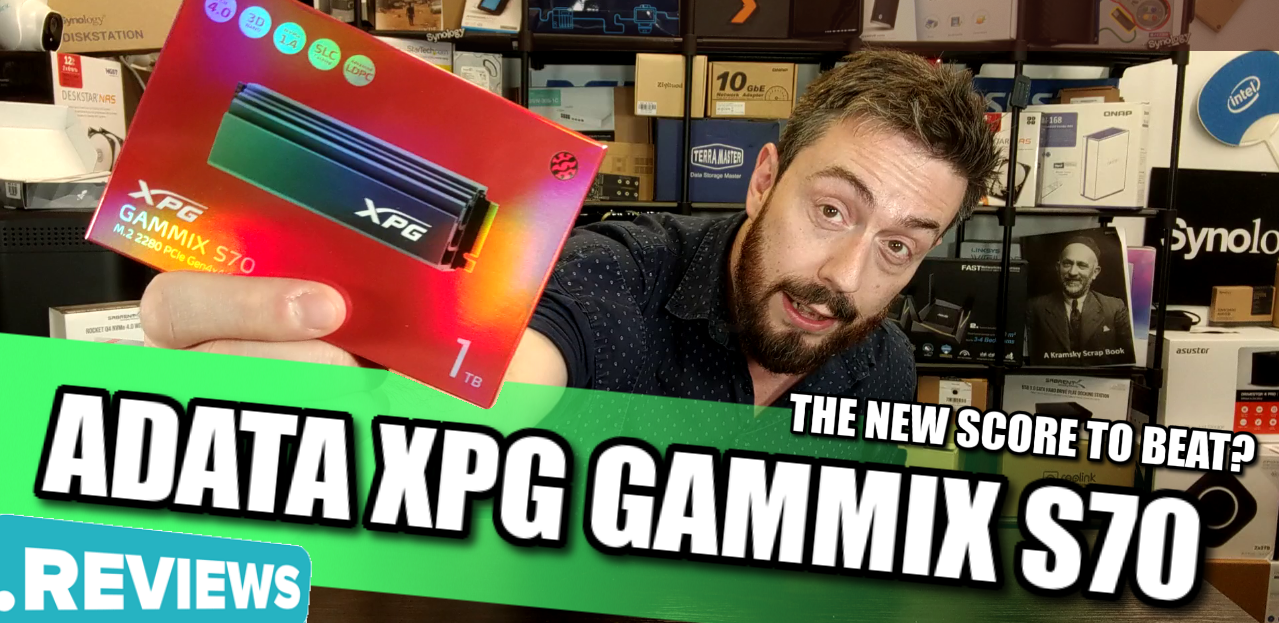







A really good & detailed video ????
REPLY ON YOUTUBE
https://youtube.com/@XPG_GAMING?si=avn1WpyQGlRqjdb7
REPLY ON YOUTUBE
Didn’t find a video about the Adata 960 legend max. Which one would you choose between the 960 legend and the Samsung 980 pro? Seq. read/ write on the Adata is higher but iops on the Samsung 980 pro are significantly higher. Which one would you recommend for the PS5? The prices are similar.
REPLY ON YOUTUBE
Any difference between this and the white one? They’re both the same speeds and both say that they’re compatible with PS5 but the white one is slightly cheaper?
REPLY ON YOUTUBE
Nice review and excellent cadence without stuttering. You sound polished.
I’m looking at my temps and it’s weird that my two 1tb xpg gamix are at 57C and 52C at idle. I’ve got a 6600xt and a 5600x on a msi x570 tomahawk. Everything is actually pretty high with my cpu at about 55C idle. It’s in a Lian Li Lian-Li PC-O11DX 011 case. Not sure what I’m doing incorrectly to have such high idle temps.
REPLY ON YOUTUBE
we don’t need a 30min on an ssd! I just wanna know if I should get it for my PS5. -_-
REPLY ON YOUTUBE
Adata XPG GAMMIX S70 Saturday I’ll try it out and tag you in video
REPLY ON YOUTUBE
Can you safely remove the Heatsink though? My motherboard requires its own heatsink being installed over the SSD
REPLY ON YOUTUBE
Can anyone tell me if the XPG GAMMIX S70 is compatible with laptop Dell G3 15 3590. And if it will fit because of your shape.
REPLY ON YOUTUBE
Hi, Have you made a temperatur test for this model with the included heatsink, and without the PS5 plate cover.
REPLY ON YOUTUBE
My m.2 screw is stripped to shit. Does anyone know if i can get it replaced?
REPLY ON YOUTUBE
Nice review! Can I use the SSD without the heatsink?
REPLY ON YOUTUBE
Can I combine my XPG SDD BLADE with it’s aluminum plate heatsinck and sabrent ps5 heatsinck ? Any harm could happen? Would affect the temperature?
REPLY ON YOUTUBE
Where I can download this firmware – 3.2.9.V ???
REPLY ON YOUTUBE
Hi, with out installing the ssd into my computer, how would I go about updating my firmware on my xpg s70 blade prior to installing it into my ps5?
REPLY ON YOUTUBE
For those that purchased this…how is it so far? I just preordered the 1tb with the slim heatsink. Any issues with it?
REPLY ON YOUTUBE
just got it from Amazon using their 35% off voucher. No brainer for a 1tb. Go now guys
REPLY ON YOUTUBE
Gonna pull the trigger on this SSD to pair with my Ryzen 9 5900X. BestBuy Canada has the 2tb model on sale rn $330 ($130 off!) so ty NAS you just saved me hundreds of dollars. Sorry Seagate nt though!
REPLY ON YOUTUBE
I’ve installed this as is into my PS5.. But wonder will I have issues because of its heatsink??? Anybody know???
REPLY ON YOUTUBE
Hey bro will it work on my HP omen 15 RTX 3060 model?
REPLY ON YOUTUBE
In the CrystalDiskMark why does this SSD get 1.000.000 IOPS when its advertised that only gets 350.000 on the 1 TB version ??
REPLY ON YOUTUBE
Have you tested it while its in a chipset slot? Even with firmware 3.2.F.2A the S70 blade seems to have the same problem WD SN850 was having before their latest firmware update, when connected to a chipset slot the write speed drops to 60% of its normal speed, the read speed stays the same, its odd
REPLY ON YOUTUBE
Shoot am I canceling my wd black sn 850 2tb order?
REPLY ON YOUTUBE
What if you don’t have a pc to upgrade firmware and only a Mac m1.. I heard updating it bricks it to
REPLY ON YOUTUBE
You’re supposed to test the very same memory but it has to have the word “Blade” in it in order to fit in the PS5
REPLY ON YOUTUBE
I actually got the blade edition 1tb for £144 on Amazon a few days ago. And 2tb for my cousin for £288.
REPLY ON YOUTUBE
Can you show the installation of third party heatsinks on this drive. The official review states that the heatsink is not removable.
REPLY ON YOUTUBE
Wonder how poor console noobs will be able to update the ssd on their ps5 since it’s not like a real gaming machine that lets you all this stuff. Doubt they will. This does look really good but I’ll probably still stay with the fire cuda since I need the 4tb unless brand has that too.
REPLY ON YOUTUBE
Another great video. Just FYI this is the ps5 and laptop friendly version of this drive. XPG GAMMIX S70 Blade 2TB PCIe Gen4 M.2 2280 Internal SSD Up to 7,400 MB/s (AGAMMIXS70B-2T-CS) no idea why the font came out so big sorry.
REPLY ON YOUTUBE
You are the best Bro????????????????????????
REPLY ON YOUTUBE
PNY XLR8 CS3140
REPLY ON YOUTUBE
thank
REPLY ON YOUTUBE
Hey! Cool! My comment is in your video!
REPLY ON YOUTUBE
Thank you!!! Finally was looking forward for this!!! Was a real surprise. Could you review the s70 blade for the ps5 ? Please
REPLY ON YOUTUBE
Can you test in the ps5? Please and thank you.
REPLY ON YOUTUBE
Quietly cancels order for Firecuda…
Orders Gammix S70 Blade.
Puts $76 savings aside to buy Horizon Forbidden West.
Smiles contentedly.
REPLY ON YOUTUBE
Would love to see the bench tests on the 2tb variant and still happy to send you it if you wish. ????
Shame you wasn’t able to test using same hardware as used on the others, just wonder if results might have been different as have seen higher read and write, however still shows that it performs extremely well specially from price point.
Look forward to the PS5 tests as I have seen the 2tb hit 6840 since the latest firmware update so would expect the 1tb to hit around the 6500. ????????
REPLY ON YOUTUBE
I would like to see a test for PS5. Can you do it? Also how hot it gets?
REPLY ON YOUTUBE
Great speeds for price performance. I still think its massively overkill for like 99% of people who wont notice a real world difference between these kinds of speeds and speeds from something like the 980pro. Drives are so fast now the difference is getting so small.
REPLY ON YOUTUBE
Please could you tell me if this Is compatible with PS5 thank you
REPLY ON YOUTUBE